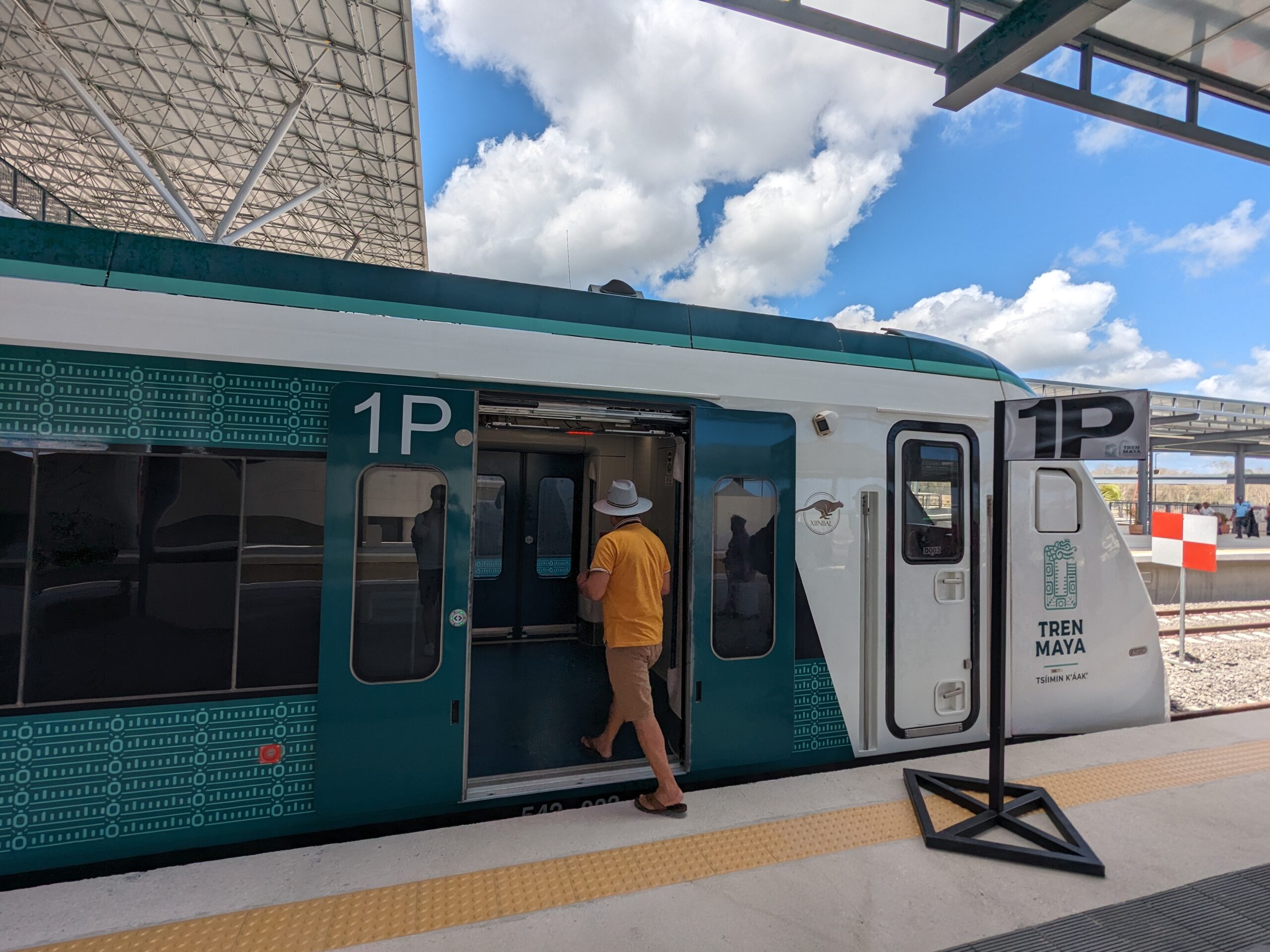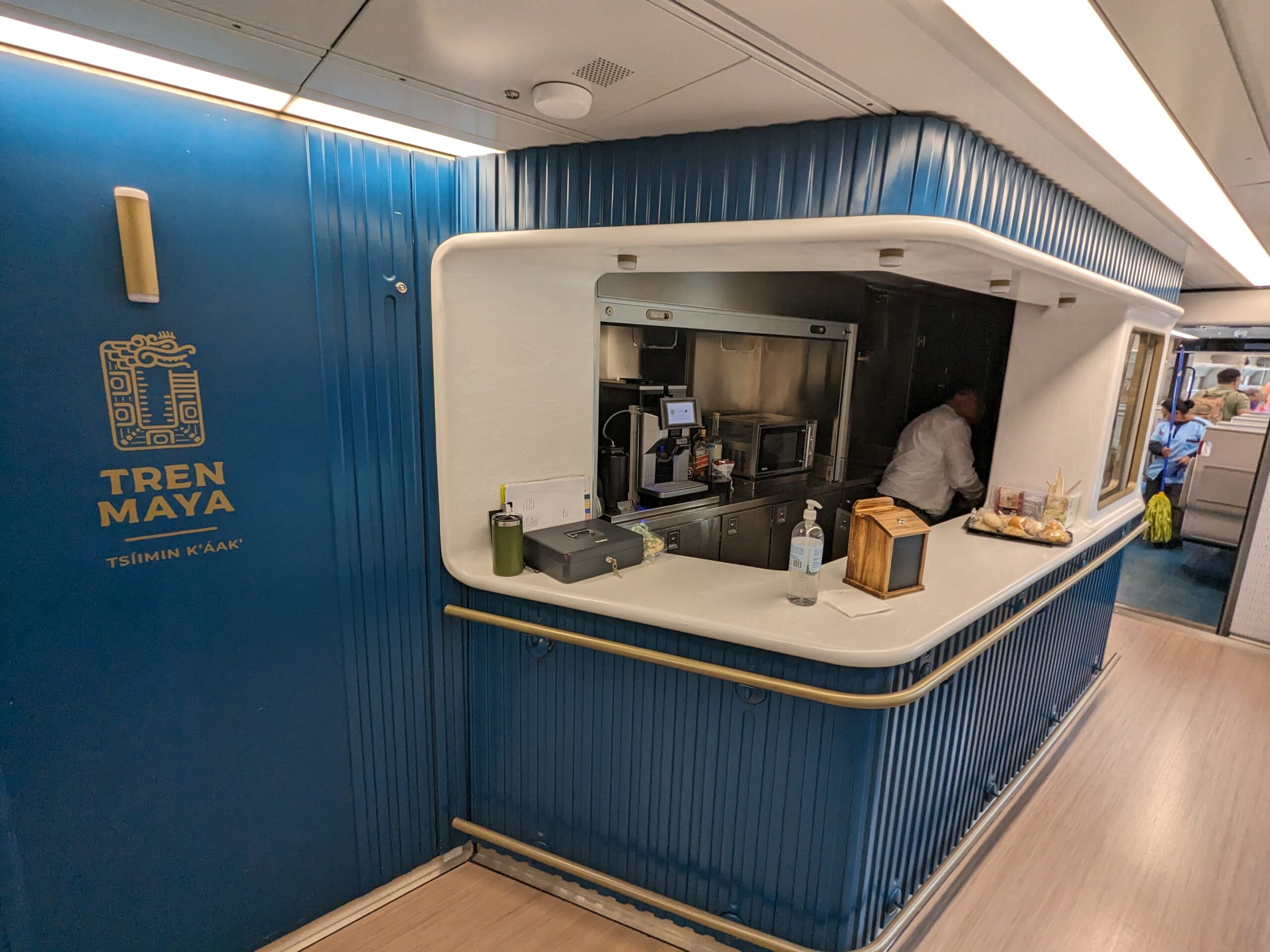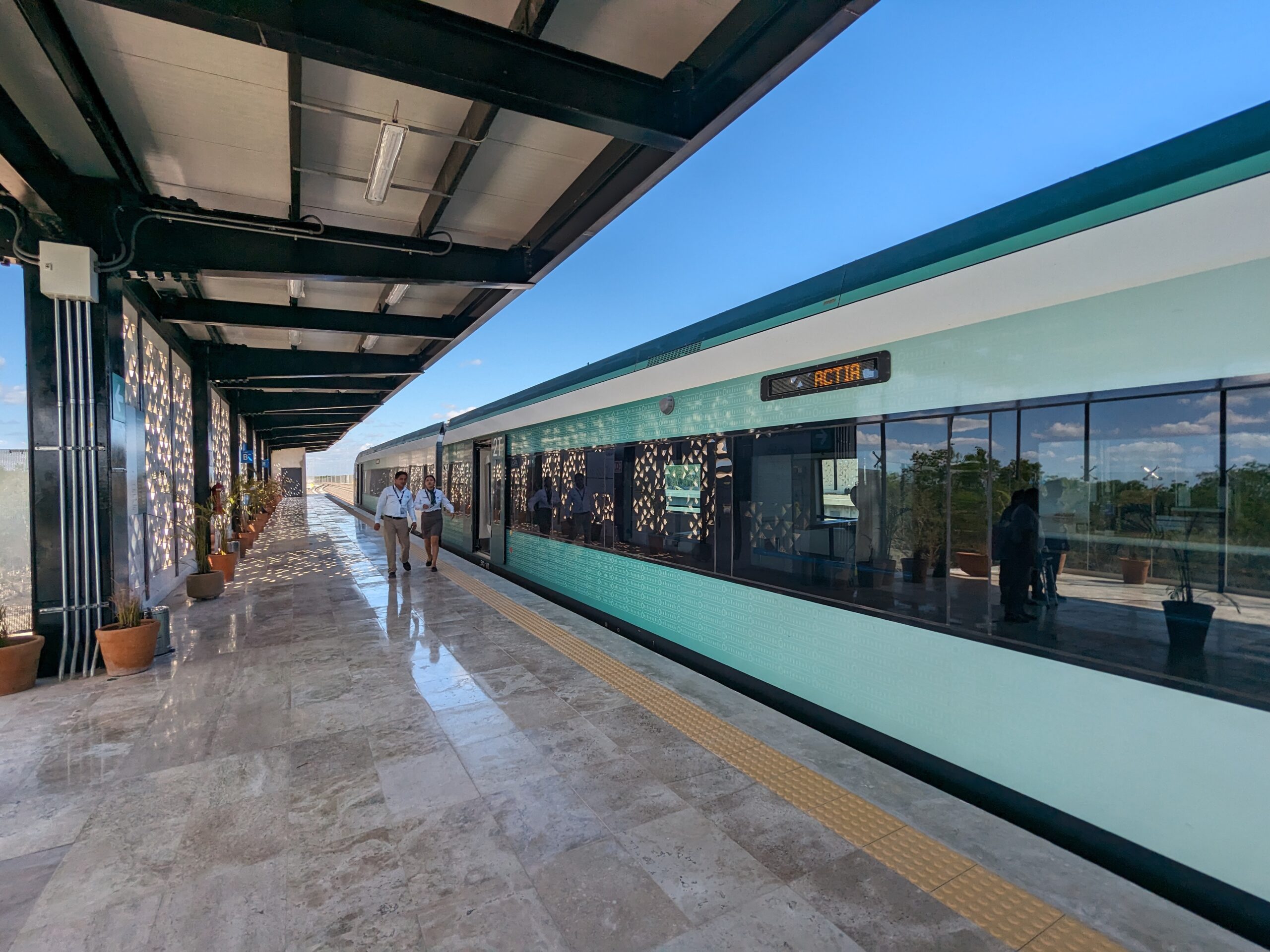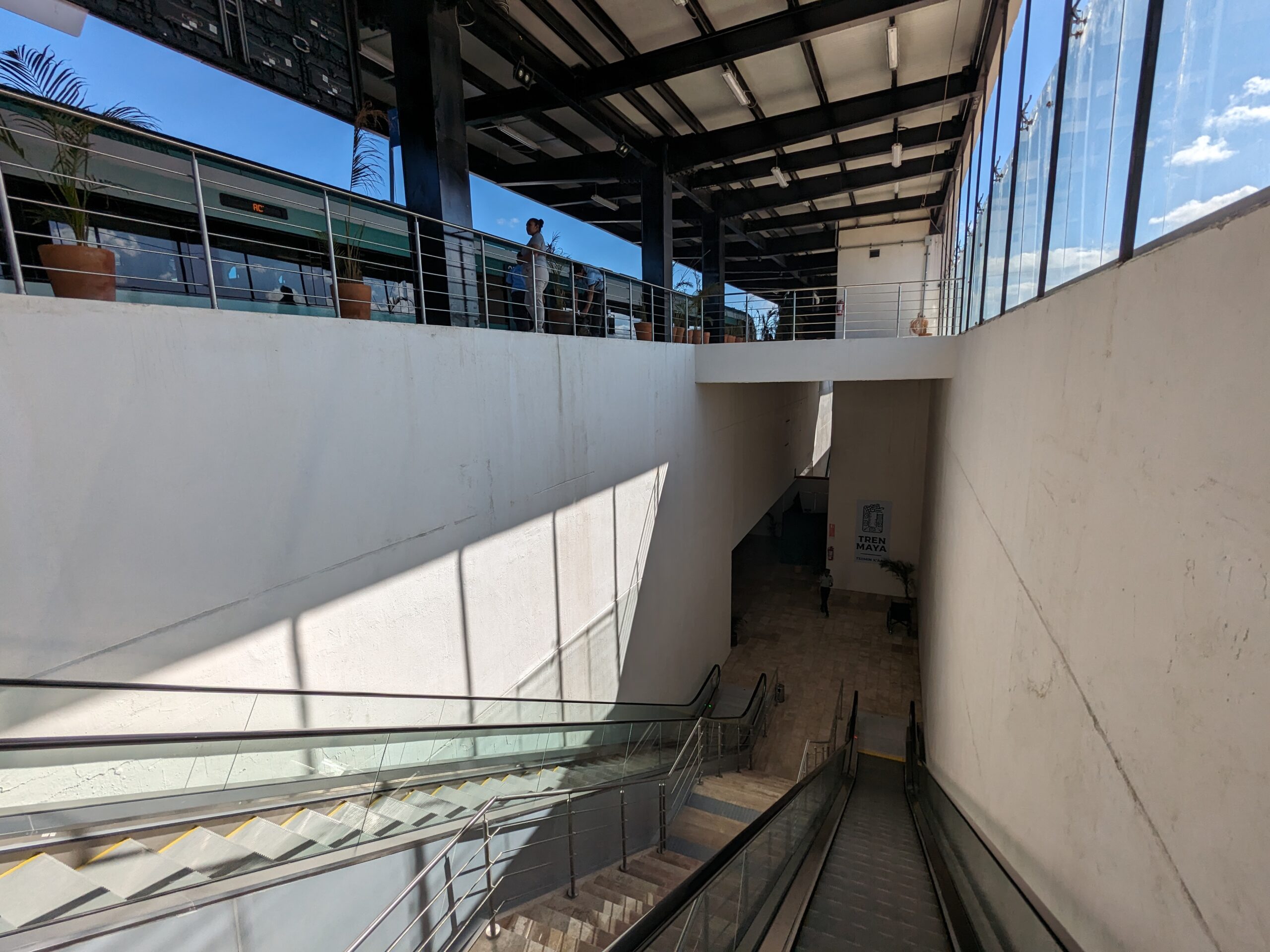Review: What’s it Like Riding Mexico’s Maya Train?
15 min readTravelers flock to Mexico’s Yucatán Peninsula in search of sun, sand, and relaxation. But getting from the Cancún International Airport (CUN) to many popular resort towns or attractions isn’t always easy … or cheap.
And that’s exactly the problem that Mexican President Andrés Manuel López Obrador’s $28 Billion Tren Maya aims to solve.
The Maya Train (or Tren Maya in Spanish) is a scenic passenger rail network, linking tourist hotspots around the region like Cancún, Playa del Carmen, and Tulum – as well as popular archeological sites like Chichén Itzá and many other, lesser-known cities and towns throughout southern Mexico. Once complete, it’ll run 1,545 kilometers (about 960 miles) across five Mexican states, reaching speeds of up to 99 miles per hour – and, reportedly, partially electric.
Much like the new airport in Tulum (TQO), this train line popped up fast: The massive infrastructure project broke ground just over three years ago. The Mayan train officially opened to travelers in December, and as of publication, there are about 24 stations online. The entire rail line is scheduled to be completed by the end of June, with 42 trains servicing 34 stations total.
After the latest section of track between Cancún and Playa del Carmen opened in late February just in time for my trip to the the Yucatán, I decided to check it out for myself.
Here’s a firsthand look at what it’s like riding Mexico’s new Maya Train.
Where Does the Maya Train Go?
When finished, the Maya Train will run through five of Mexico’s states – Chiapas, Tabasco, Campeche, Yucatán, and Quintana Roo, connecting some of the Yucatán Peninsula’s most iconic destinations with lesser-known cities and towns.
For tourists looking to see something other than the beach, the train serves as a gateway to the region’s many archeological wonders like Chichén Itzá and other ancient Mayan sites. It will also provide access to many of Mexico’s famed cenotes – or natural underground pools.
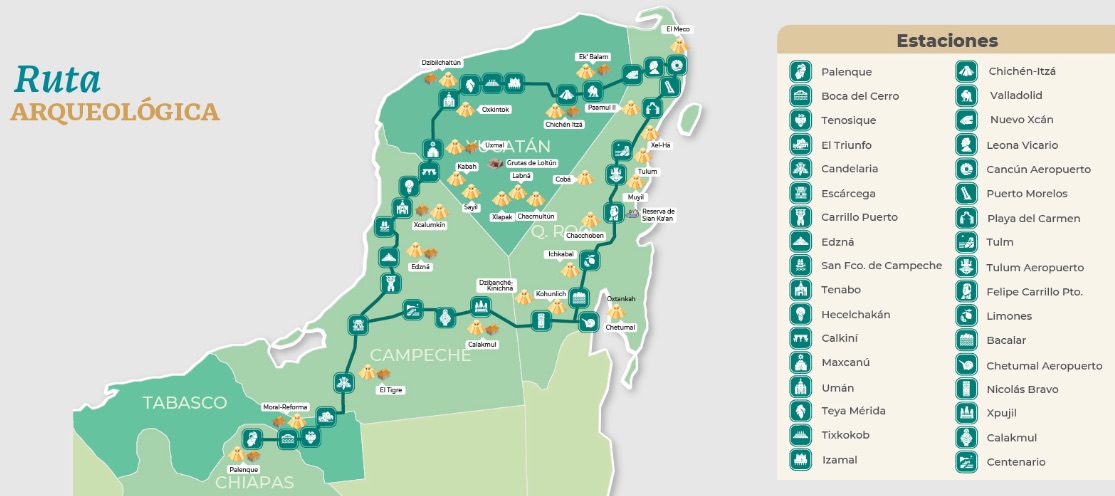
The new train should make day trips to some of these sites possible you’re looking to take in some Mayan culture as part of your beach vacation.
While the train might seem like an obvious boom to the tourism industry, it’s also designed to transport locals from their homes to their place of employment up and down the Riviera Maya.
How to Get From the Cancún Airport to the Maya Train
Getting from the Cancún International Airport (CUN) to the train station was a bit of an adventure – but thanks to my mistakes, it doesn’t have to be the same for you.
Anyone who’s been to a Mexican resort destination is all too familiar with what’s waiting as soon as you walk out of the airport: A barrage of people looking to sell you transportation, timeshares, excursions, and more. It can be overwhelming, to say the least.
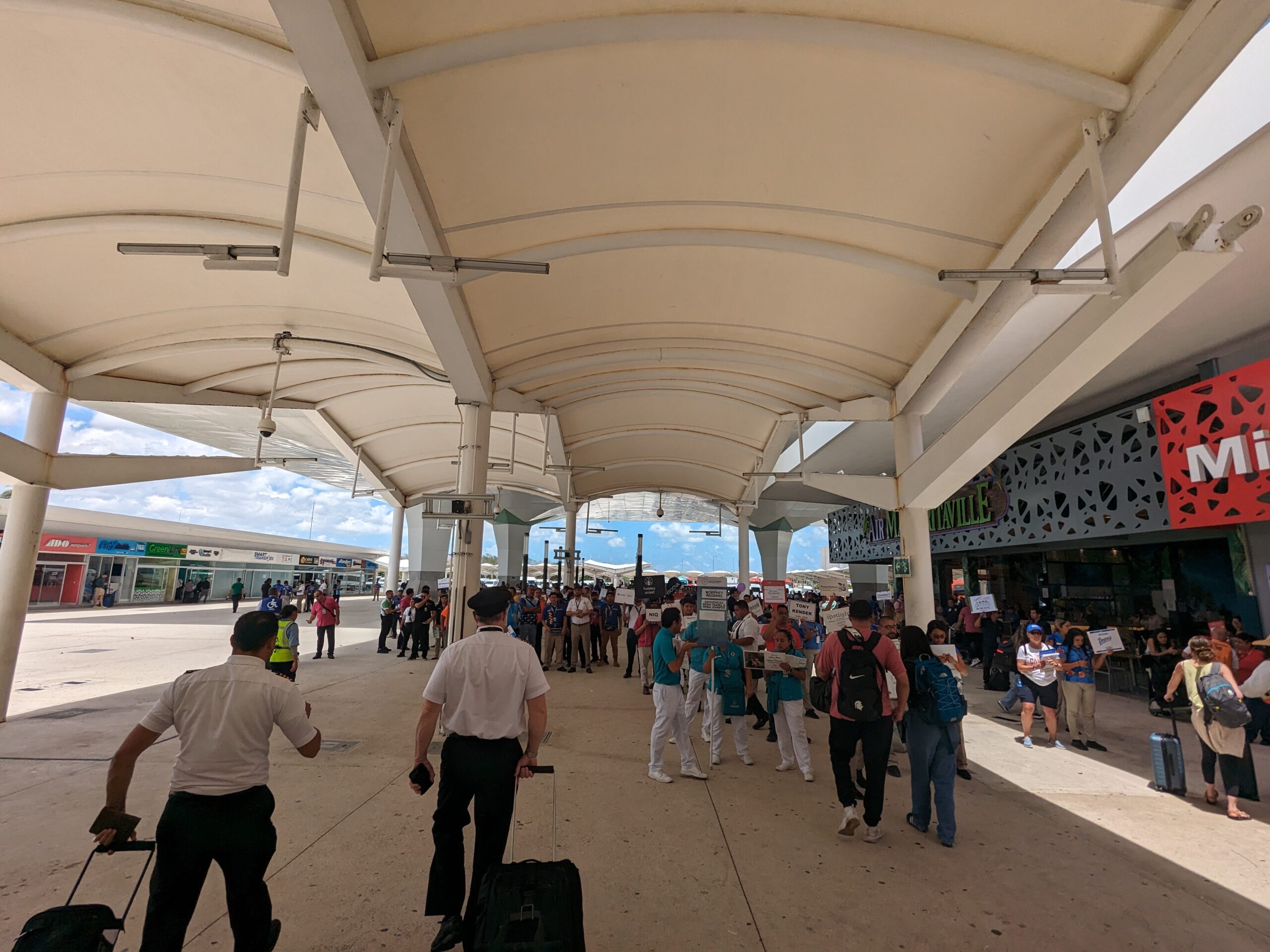
To find the shuttle pick up at Terminal 3, the main international terminal, head left immediately after you get outside. This will be before you come upon the mass of people trying to sell you everything under the sun (see above). There is a Berry Hill restaurant on the left that you’ll need to walk past and then through a turn-style gate to get to the shuttle pick-up area. Once you’re through the gate the Tren Maya shuttle pick-up will be one of the first signs you come upon.
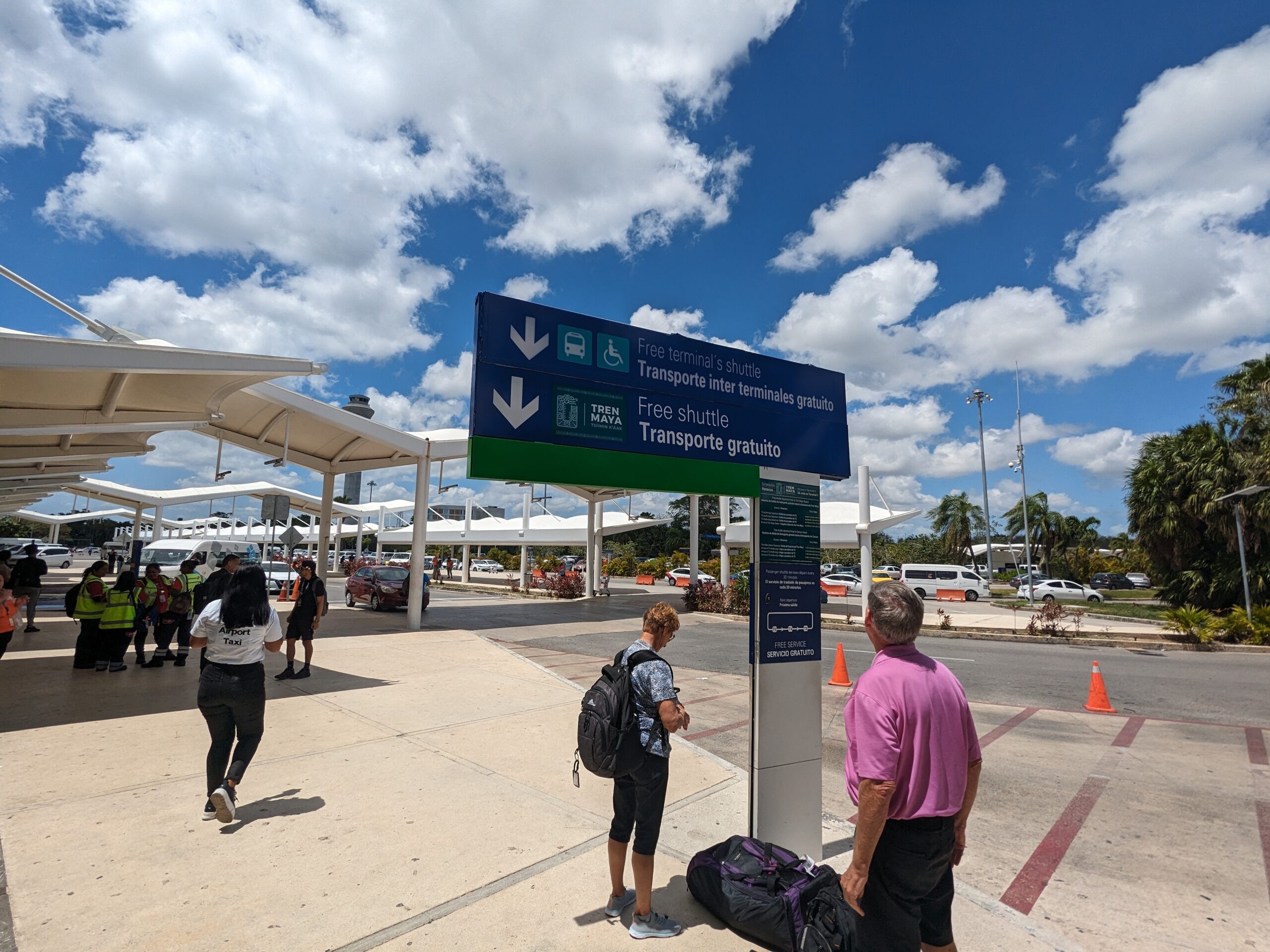
If you instead make your way into (or past) the crowd of people as I did, taxi drivers may offer to take you straight to the station – for a steep price, of course – or try to talk you out of taking the train altogether.
After wandering around for quite some time, looking for any sign of the Tren Maya shuttle (without success), I eventually caved and paid $60 for a taxi ride – no doubt a steep price considering the station is located just off the airport grounds. One driver even quoted me as much as $120 for a ride to the station so paying $60 felt like a bargain in comparison.
Wouldn’t you know it? On my way to the taxi line, I saw the sign for the official Tren Maya free shuttle service. Despite my taxi driver and the airport transportation officials swearing it isn’t yet operational, I confirmed with train officials that the free shuttle is running and will pick up and drop off passengers five times per day at Terminals 2, 3, and 4. You can see the current schedule in the photo below.
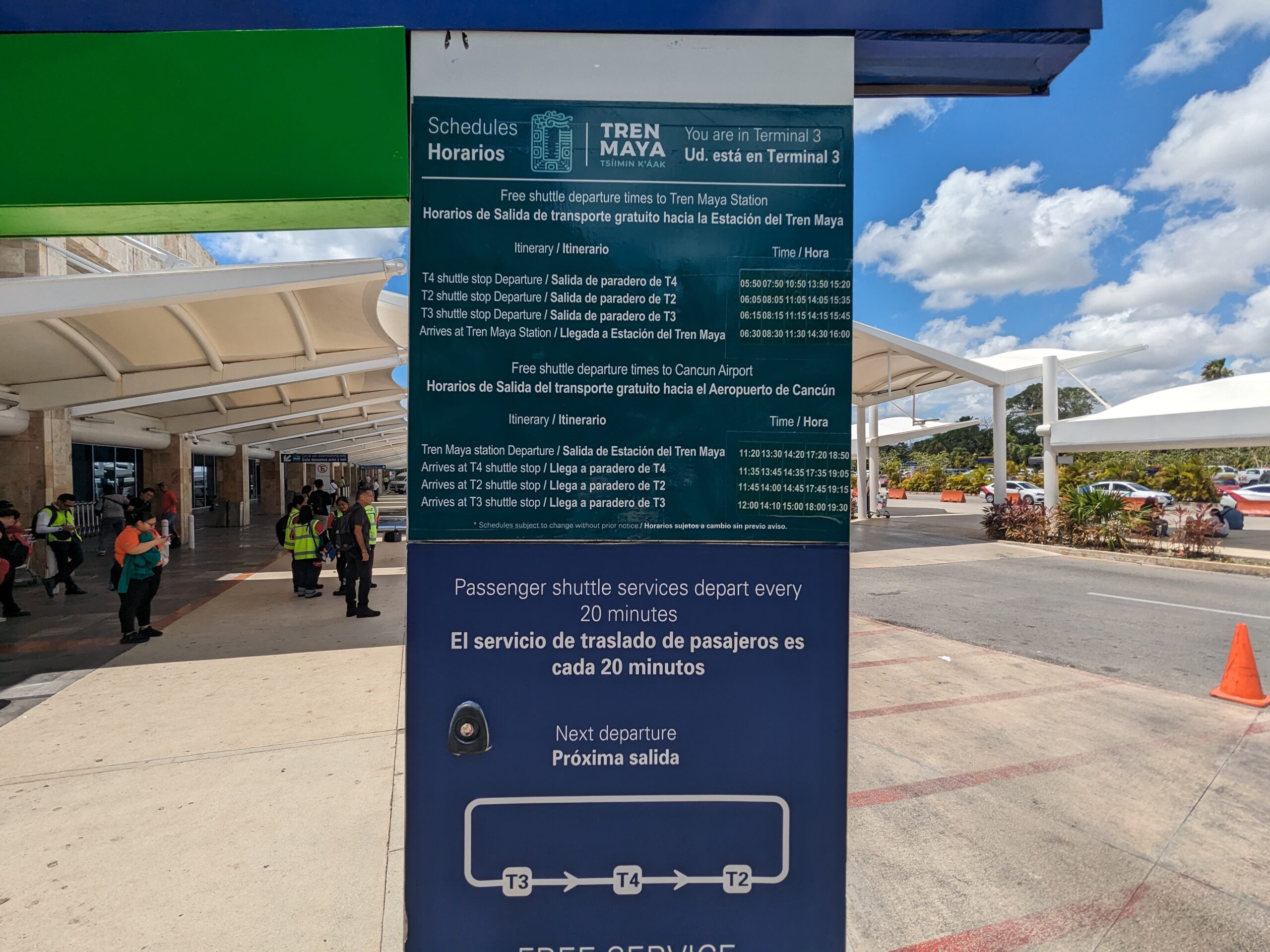
These times coincide with the train’s schedule so while you might need to wait for the shuttle, it’s either wait at the airport or the Cancún Station. Right now, you’re far better off grabbing a cold drink at Jimmy Buffet’s Margaritaville outside the airport terminal and waiting for the shuttle there than at the station (more on that below).
Thrifty Tip: Use a fee-free debit card like the Charles Schwab debit card to grab cash from an ATM before leaving the airport. While credit cards are accepted in most places, you might be able to save money by paying with cash – and you might need some to take a shuttle from the Tren Maya to your final destination.
Cancún Station
After a nearly 20-minute taxi ride (construction made for slow-moving traffic), I arrived at what can best be described as the half-finished Cancún Station – or Estación Cancún in Spanish.
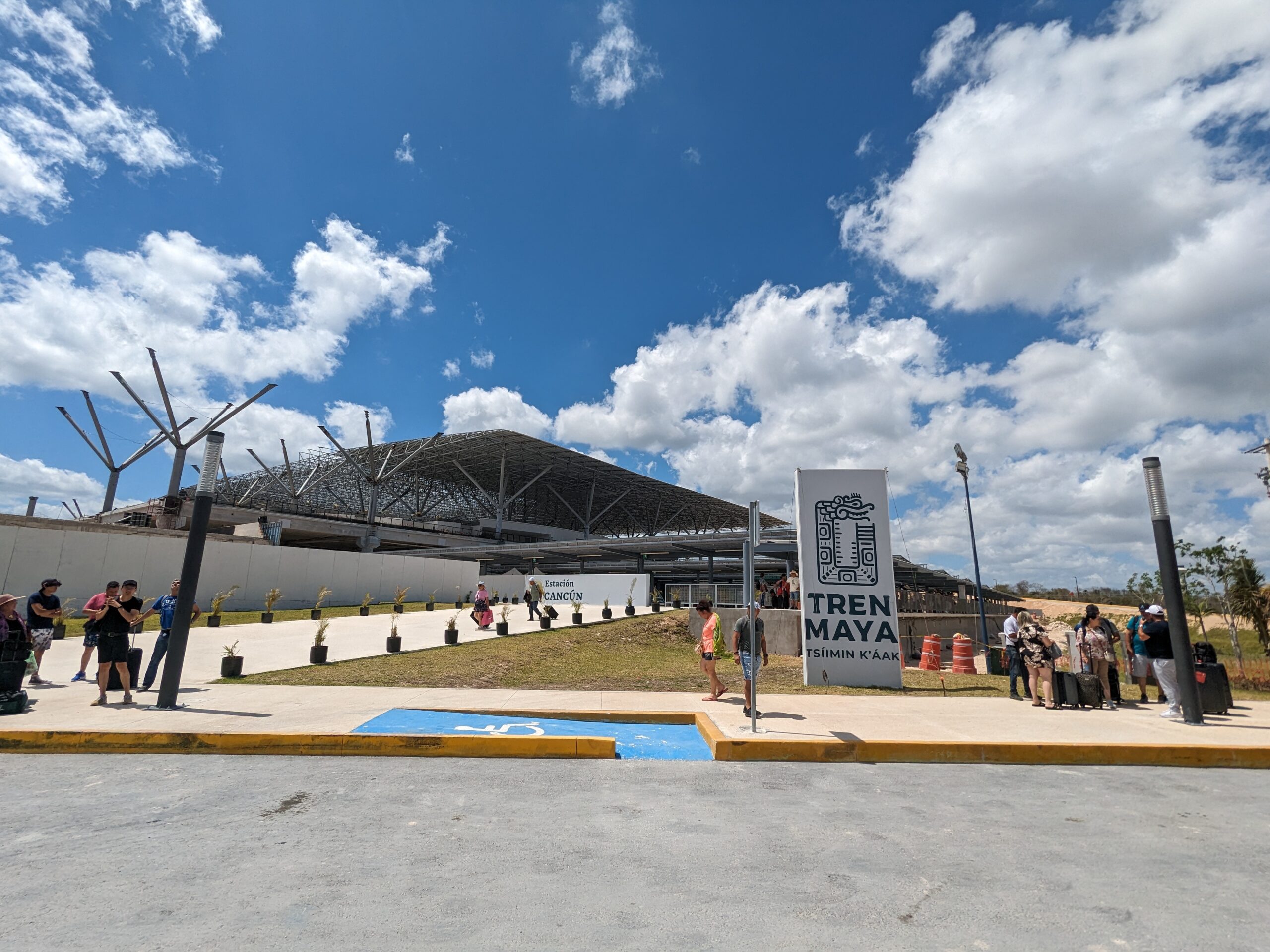
Construction was not only ongoing at the station itself, but also in the entire surrounding area. Crews are in the process of building an overpass that will allow highway traffic to move over the top of a new service road that connects the airport to the station. This service road is currently being paved and at this time is only in use by the shuttle bringing passengers between the airport and the train station.
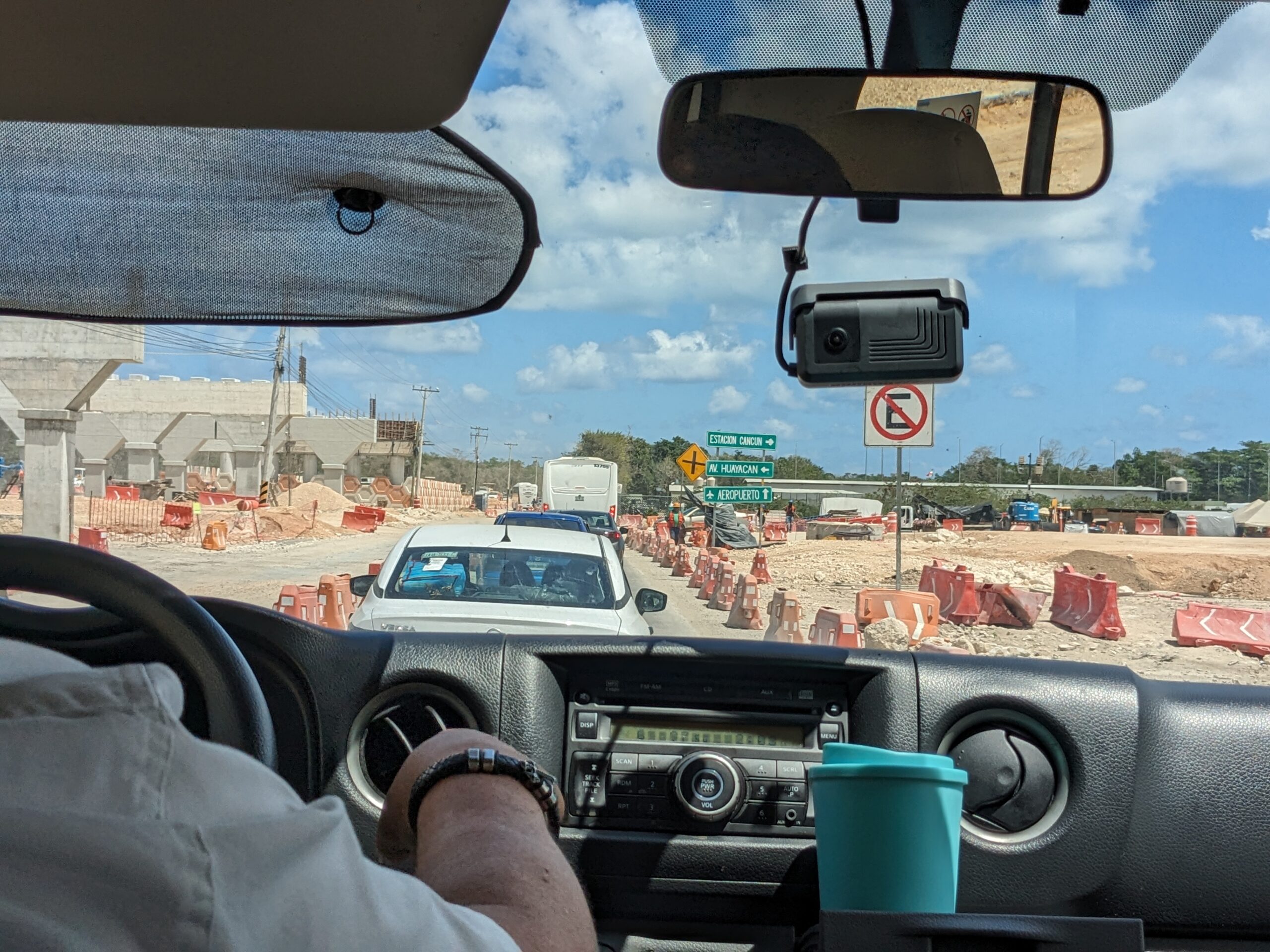
When the station is finished, it’ll be an impressive above-ground open-air structure with (from what I could tell) eight total platforms. For the time being, only two platforms are operational and there aren’t any sort of permanent facilities such as a ticket booth, concessions, or even restrooms yet.
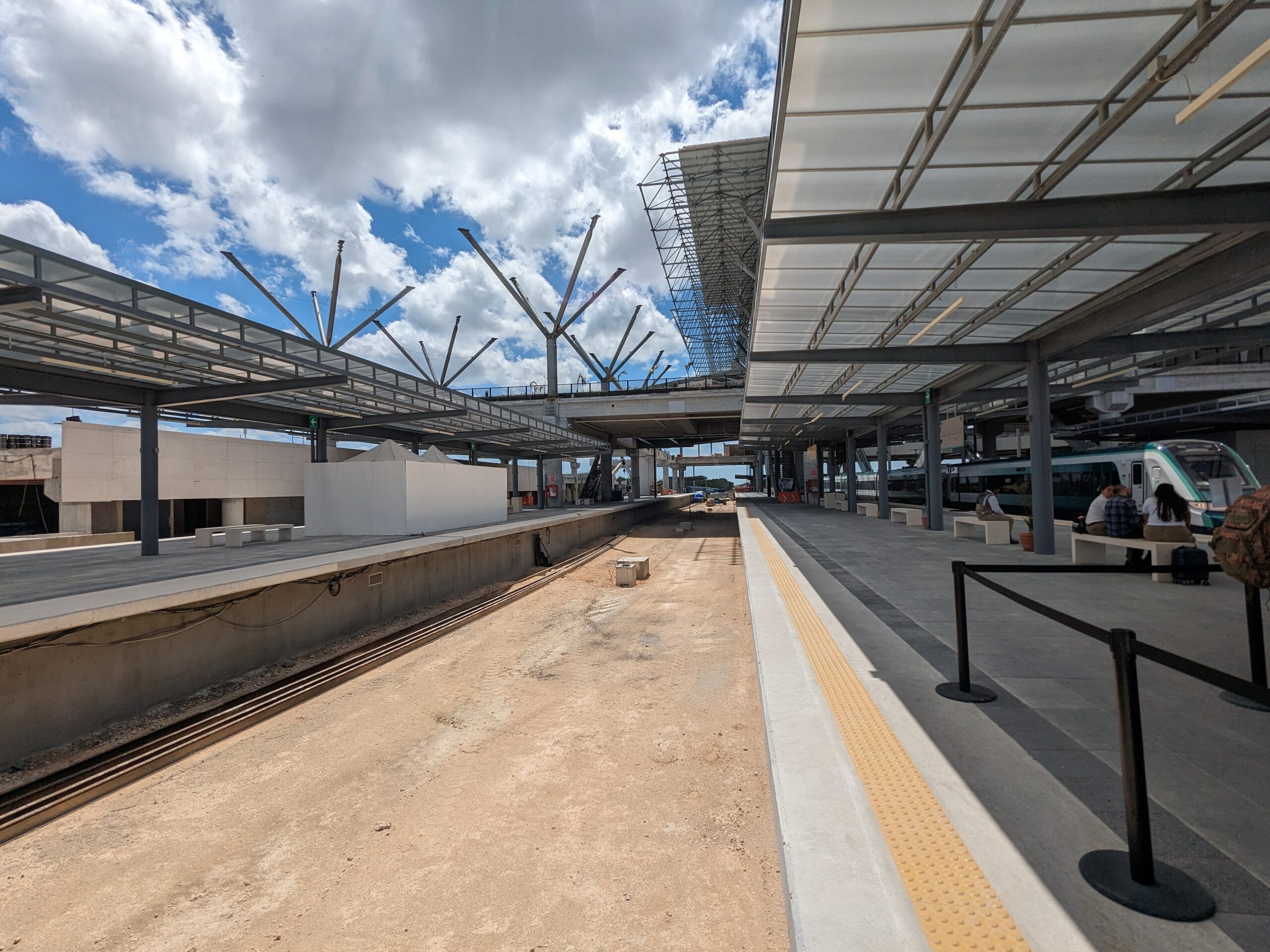
For now, there’s a single convenience store selling soft drinks, coffee, and snack items. I wouldn’t recommend arriving hungry … or any earlier than you have to, as the station is pretty bare-bones right now.
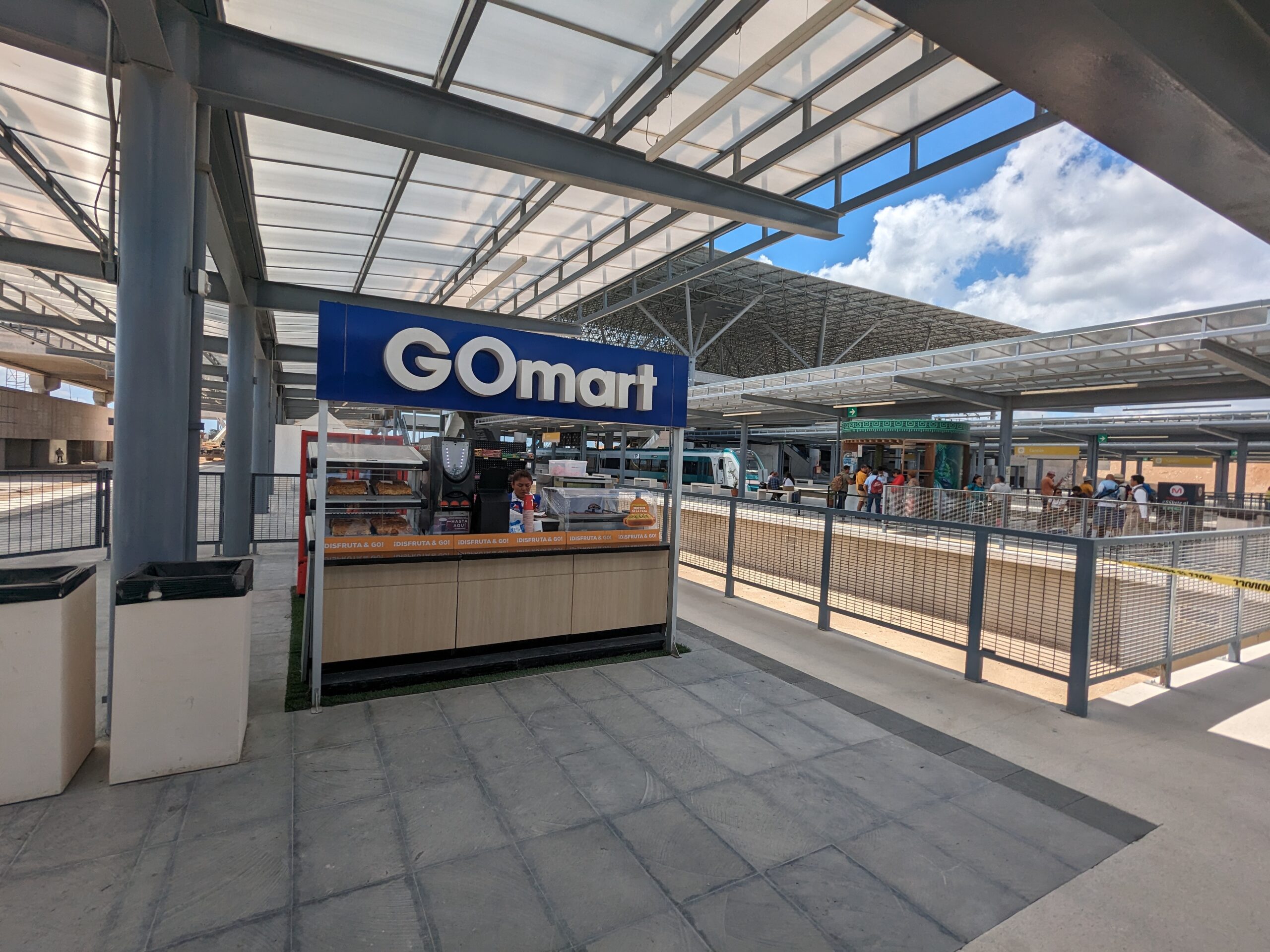
How & Where to Buy Maya Train Tickets
You can theoretically buy tickets for the Maya Train online ahead of your journey but when I tried this before my trip, Playa del Carmen station hadn’t yet been loaded as an eligible destination. It looks like that issue has been fixed however, when I checked again recently I could only find departures within the next week. If you’re trying to plan further in advance, you won’t see any available trains, even though they run three times per day in each direction.
Other reports I’ve read describe a similar experience with trying to buy tickets online ahead of time so it seems the whole ticketing system is very much a work in progress. Purchasing a ticket online in advance will save you time at the station, but you shouldn’t have to worry about the train selling out … at least not yet.
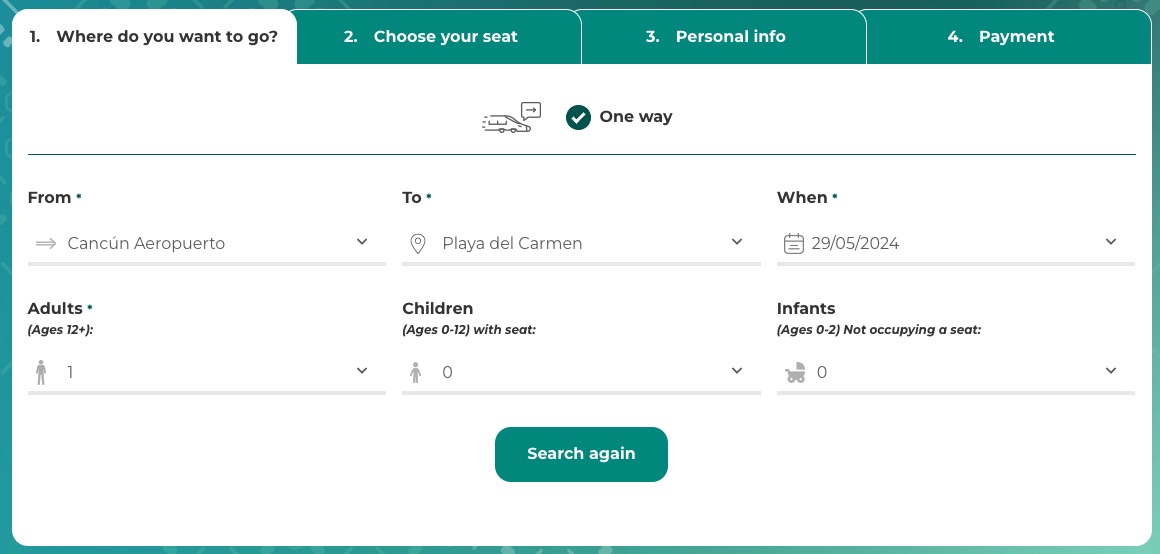
Thrifty Tip: Be sure to only use the official Tren Maya website for ticket purchases and train info. This website isn’t yet a top search result on Google so make sure you’ve got the right one.
Right now, tourist trains are scheduled to depart Cancún Station at 9 a.m., 12 p.m., and 3 p.m. for the journey south to Playa del Carmen – and eventually Tulum. In the opposite direction, trains depart Playa del Carmen station, heading north to Cancún, at 10:30 a.m., 12:30 p.m., and 4:30 p.m.
Since I wasn’t able to purchase my ticket online ahead of time, I made my way to the ticket booth as soon as I got to the station and found a line of travelers looking to do the same.
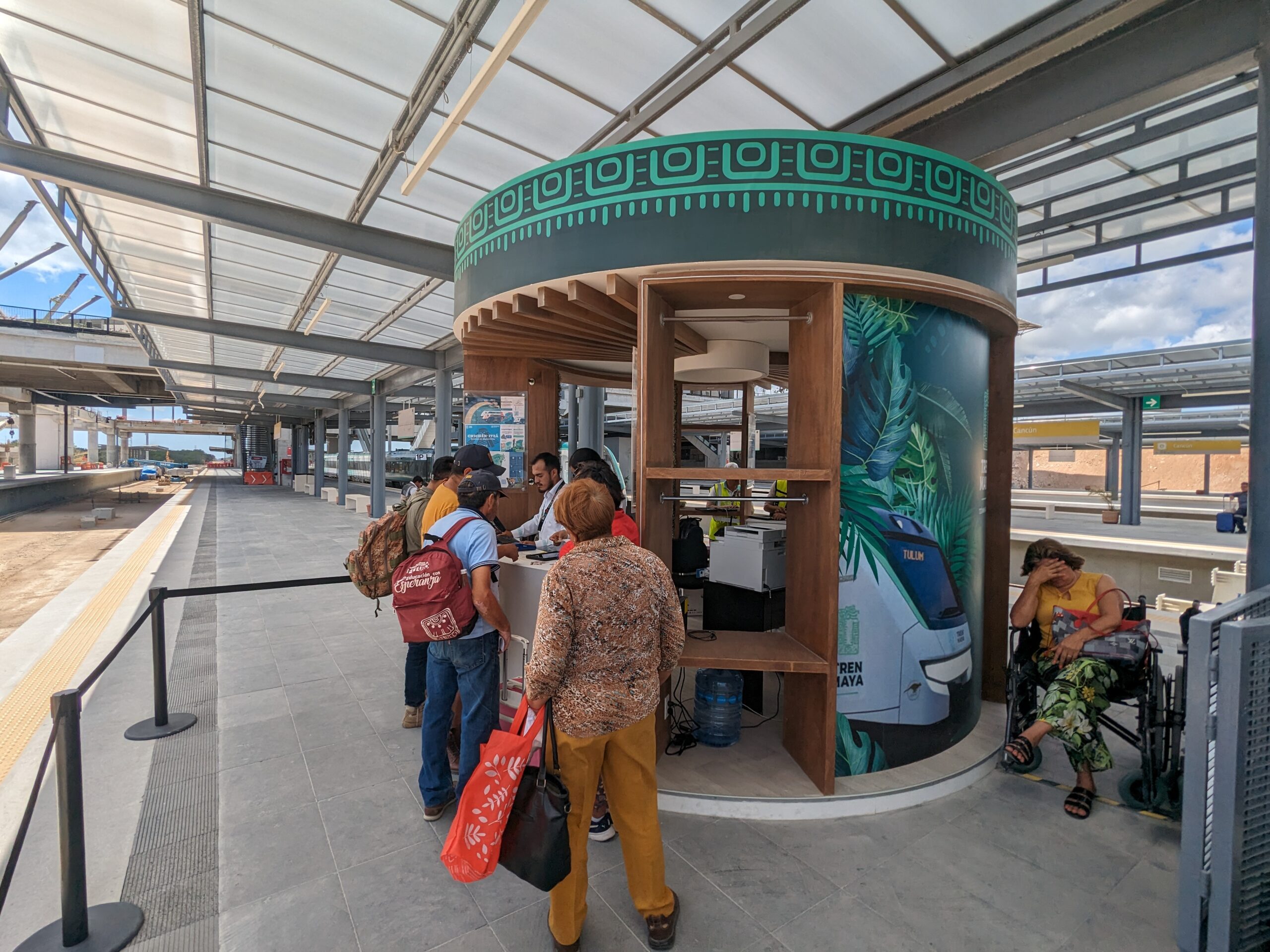
When I got to the front of the line, the ticketing representative asked for my ID and where I was traveling to. After inputting some personal info from my passport, they then flipped the iPad around to have me type in my email and phone number.
There are two different classes of service offered on this route: Premier class and Tourist class. Premier class is like first class on an airplane, with slightly more space and complimentary food and drinks, while tourist class is more like an economy class airplane experience. The different classes of service weren’t explained to me when I purchased my ticket and I was automatically assigned a Tourist class seat.
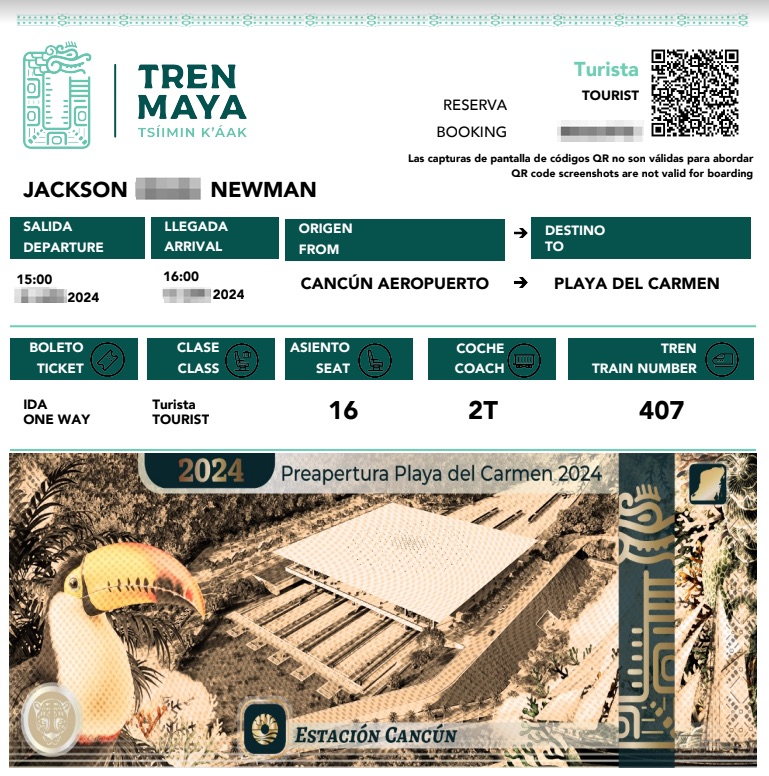
The cost of my one-way Tourist ticket from Cancún to Playa del Carmen was approximately $12. Had I been given the option and upgraded to Premier class, it would have been closer to $20 – not a huge difference for those looking for extra space and a more comfortable ride. I was able to pay for my ticket with a credit card and the receipt and ticket itself arrived in my email inbox almost immediately.
Before being allowed onto the platform my ticket was scanned and I had to show my ID again to verify that I was the actual ticket holder. I’m assuming since there are discounts for locals and Mexican nationals, they want to ensure the person who purchased the ticket is the one who’s actually traveling.
What’s It Like Onboard the Maya Train?
The train to Playa del Carmen arrived at the station approximately 30 minutes before the scheduled departure time. After all the incoming passengers got off the train, we were allowed onto the platform to board. It was clear right away that the new train was quite the novelty, as lots of passengers stopped to take pictures while boarding and there was a general buzz and sense of excitement in the air.
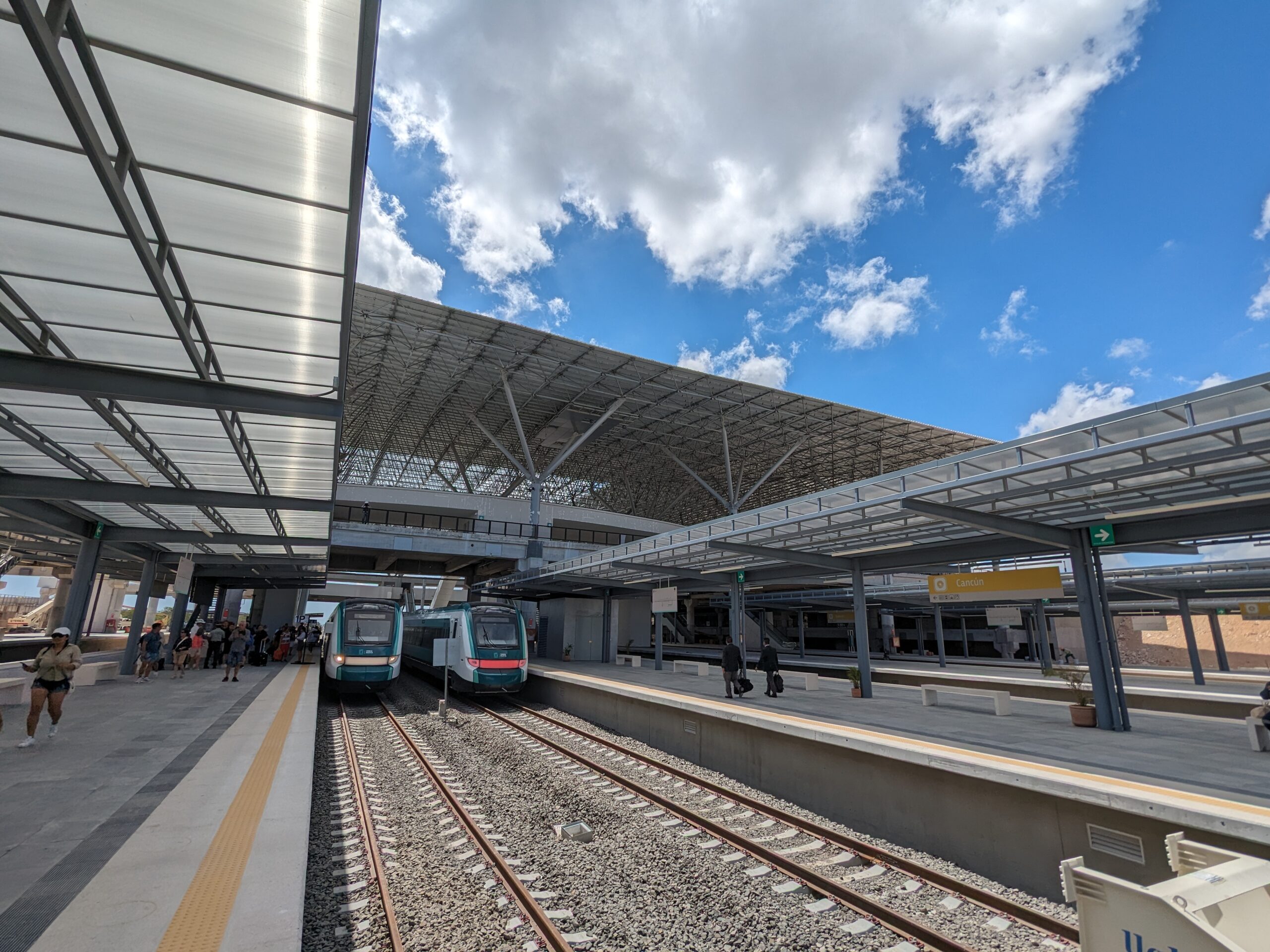
The train used on this route had four cars total: one for Premier class and the others for Tourist class.
There were two restrooms onboard – one of which was handicap accessible and included a children’s changing table. The other was much smaller, similar to what you’d find on an airplane.
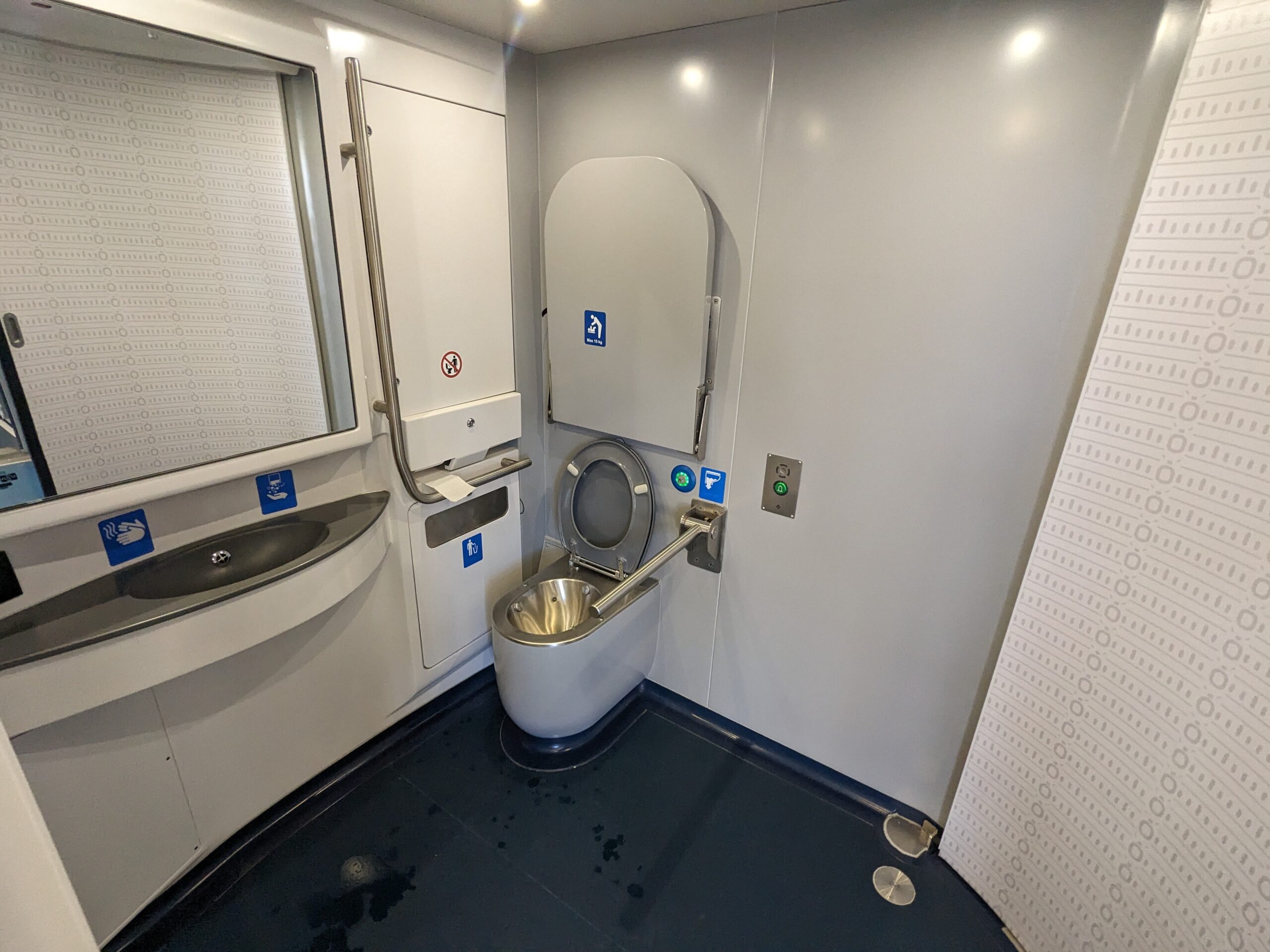
In between the Premier and Tourist class cars, there was a little restaurant that served a variety of food and beverage items.
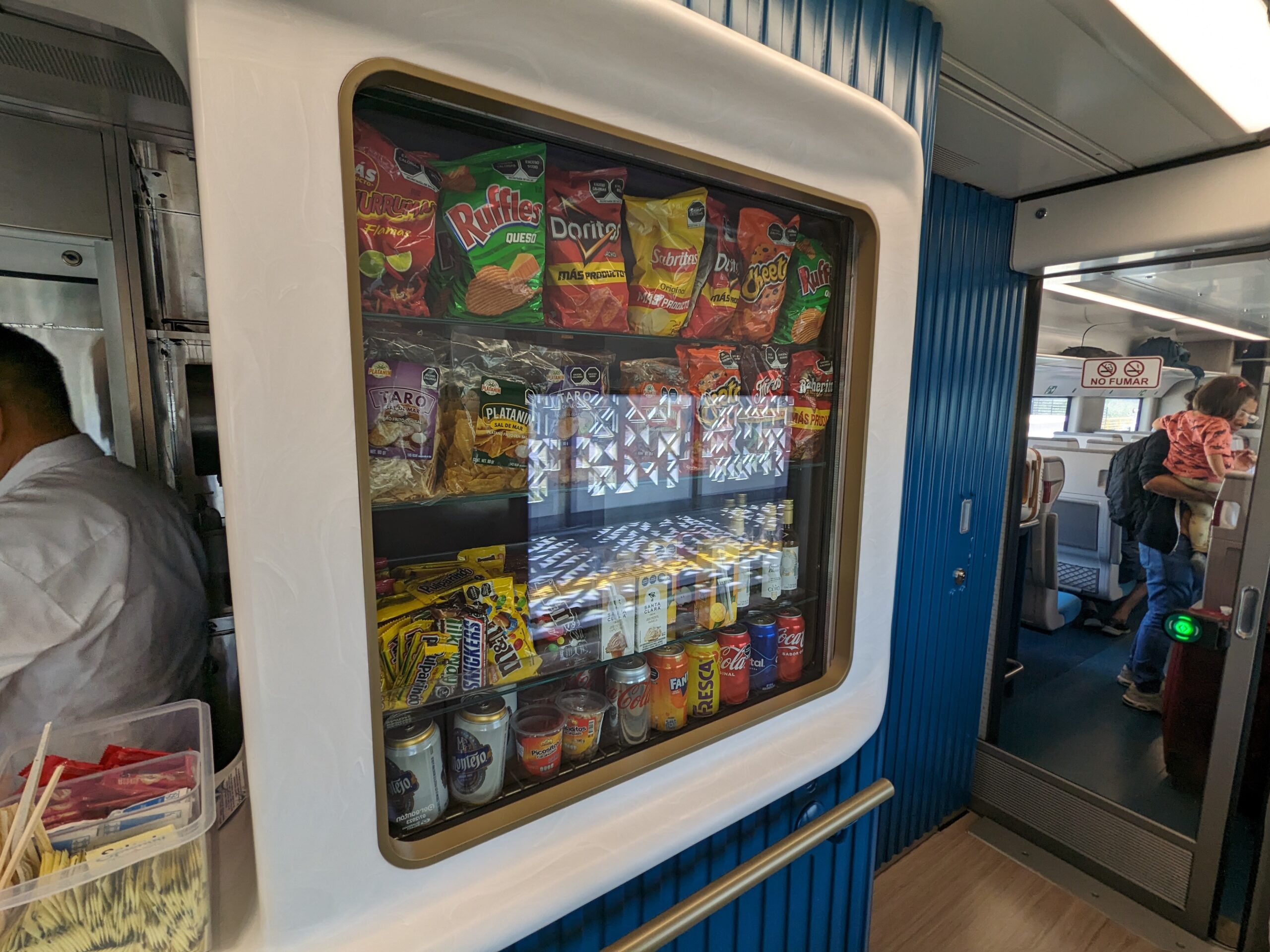
In addition to pre-packaged snacks, there were also hot food items available such as pizza, hot dogs, and sandwiches. Drink options included a variety of alcoholic and non-alcoholic offerings from soda to coffee, beer, and wine. I found the food prices to be quite reasonable – given the captive audience – with hot items in the $3 to $7 range, candy costing approximately $2, and drinks starting around $3 or slightly more for alcohol.
Premier Class
The Premier class car is arranged in a 1-2 configuration with an aisle down the middle running the length of the train. The pair seats are best for couples or families traveling together, while the single seats are ideal for solo travelers. All seats included an adjustable headrest and had room up above to store smaller pieces of luggage.
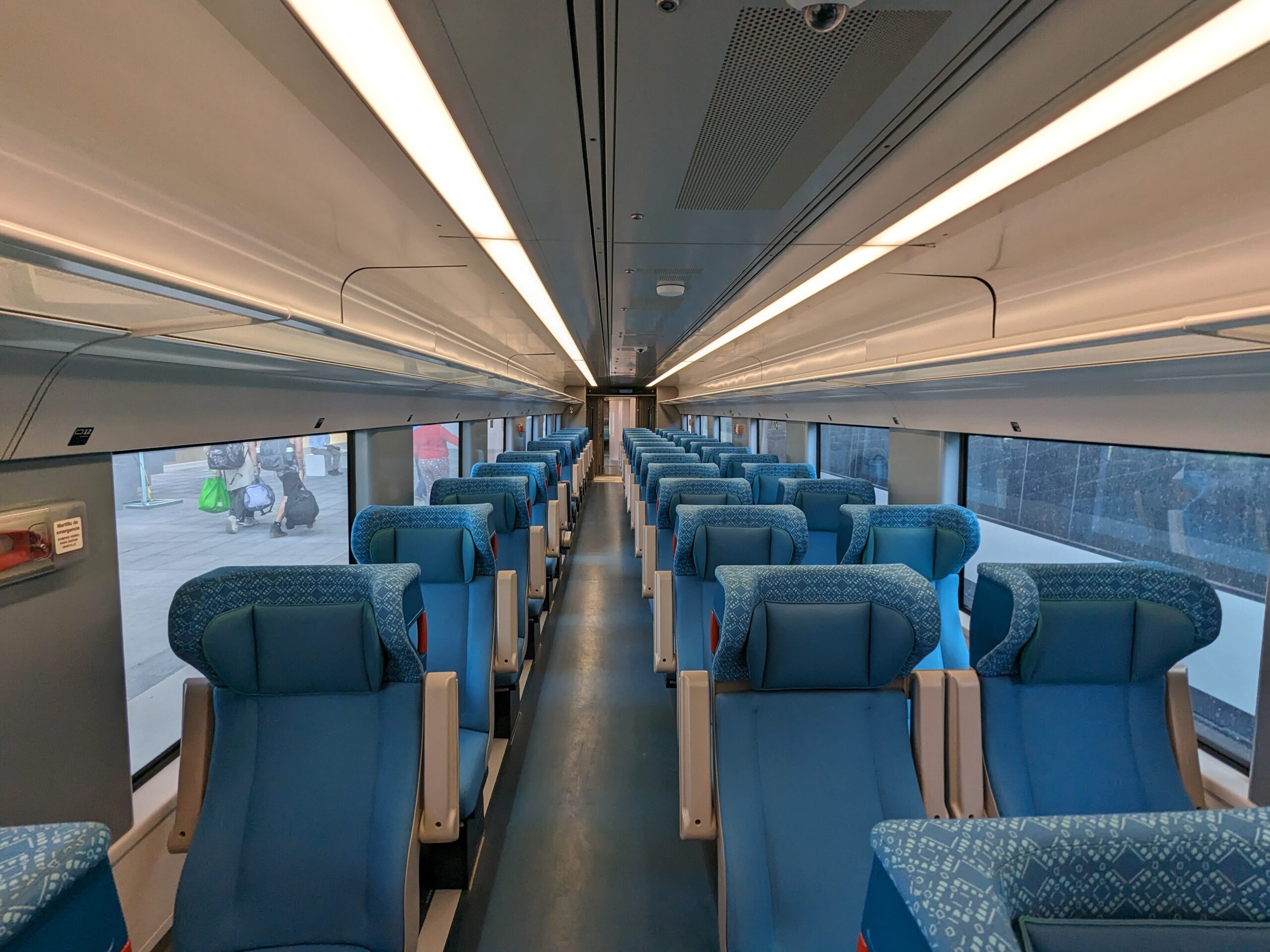
In Premier class, the seats were a little bit wider than those in Tourist class but there wasn’t a noticeable difference in legroom.
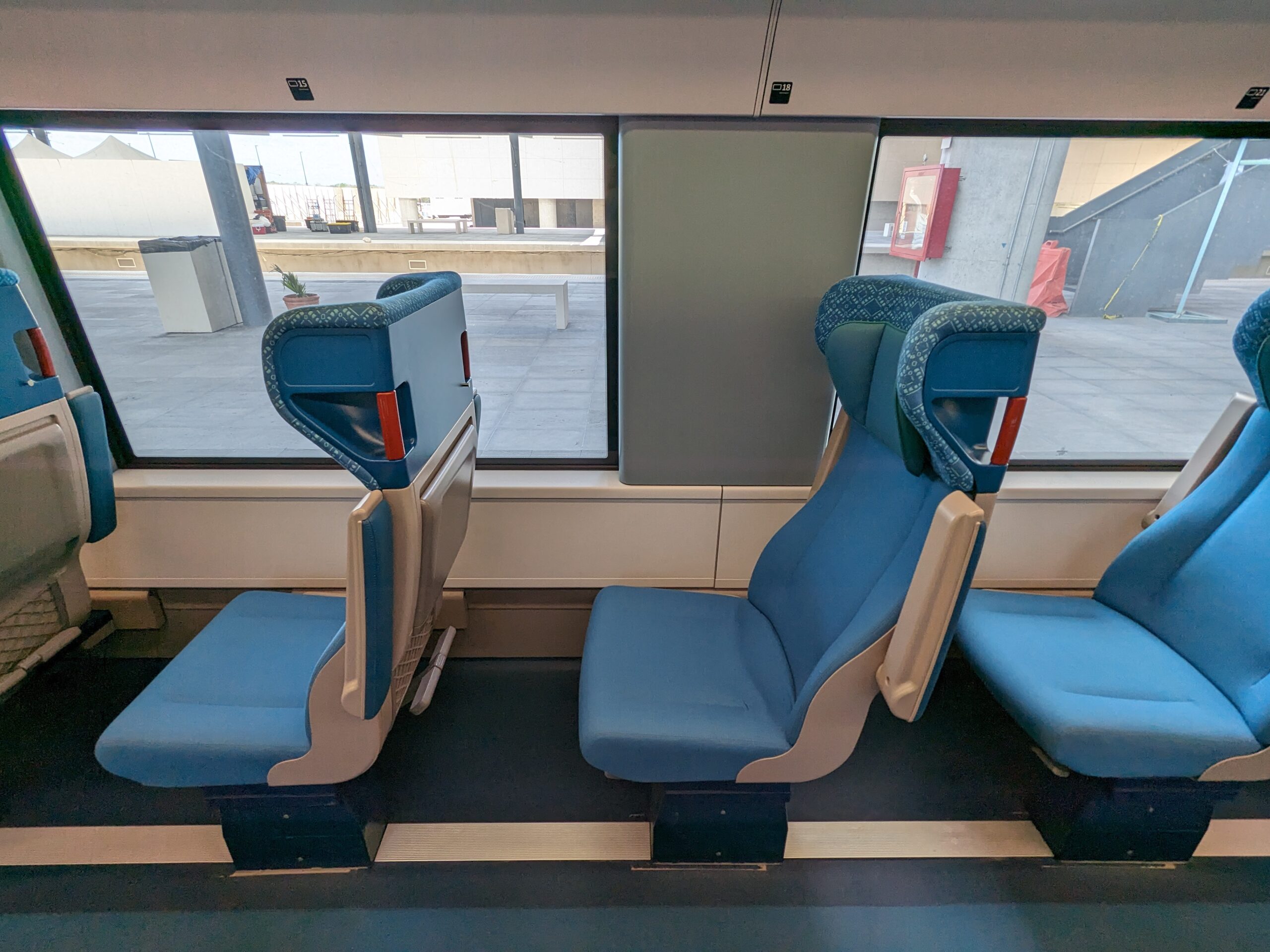
Premier class tickets also come with complimentary soft drinks and a box lunch, an additional touch of luxury for the journey.
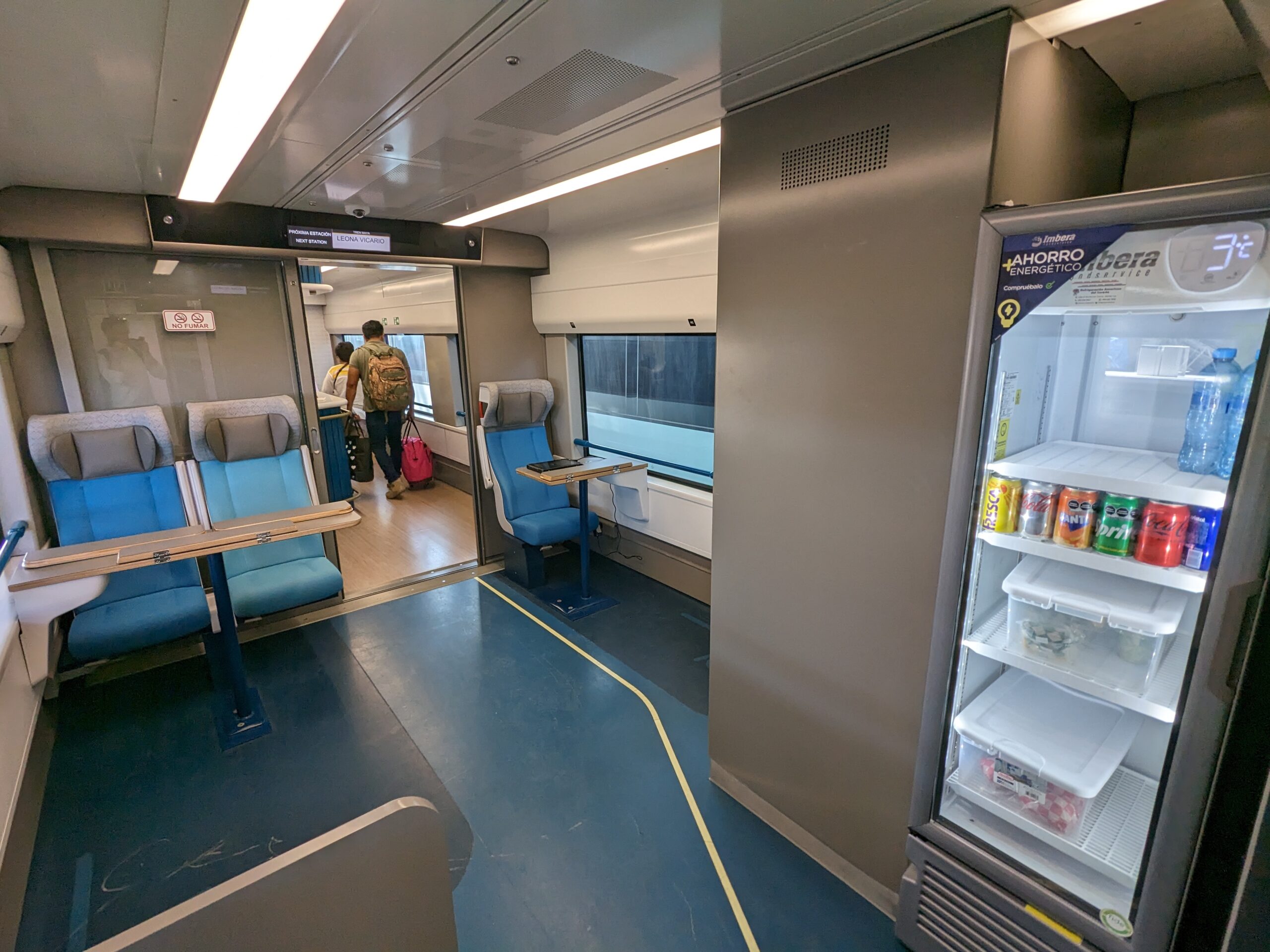
Tourist Class
The Tourist class cars had seats laid out in a 2-2 configuration, meaning slightly less shoulder room for passengers than in Premier class.
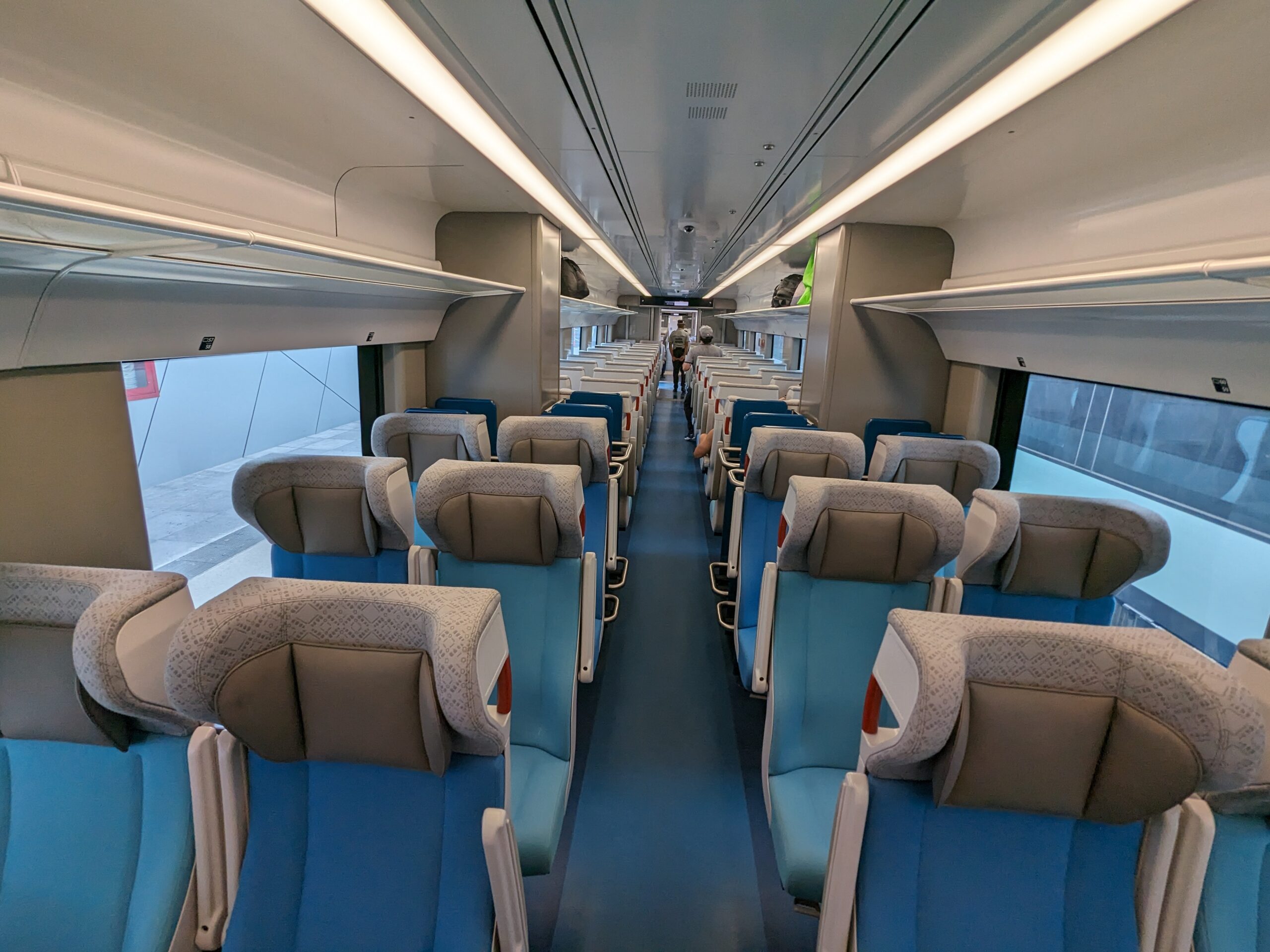
Seats in this cabin face both directions, so depending on where the train is heading, some passengers will be facing forward and some facing back. There were even some seats arranged in a pod of four with a table in the middle. This setup would be ideal for families or groups traveling together.
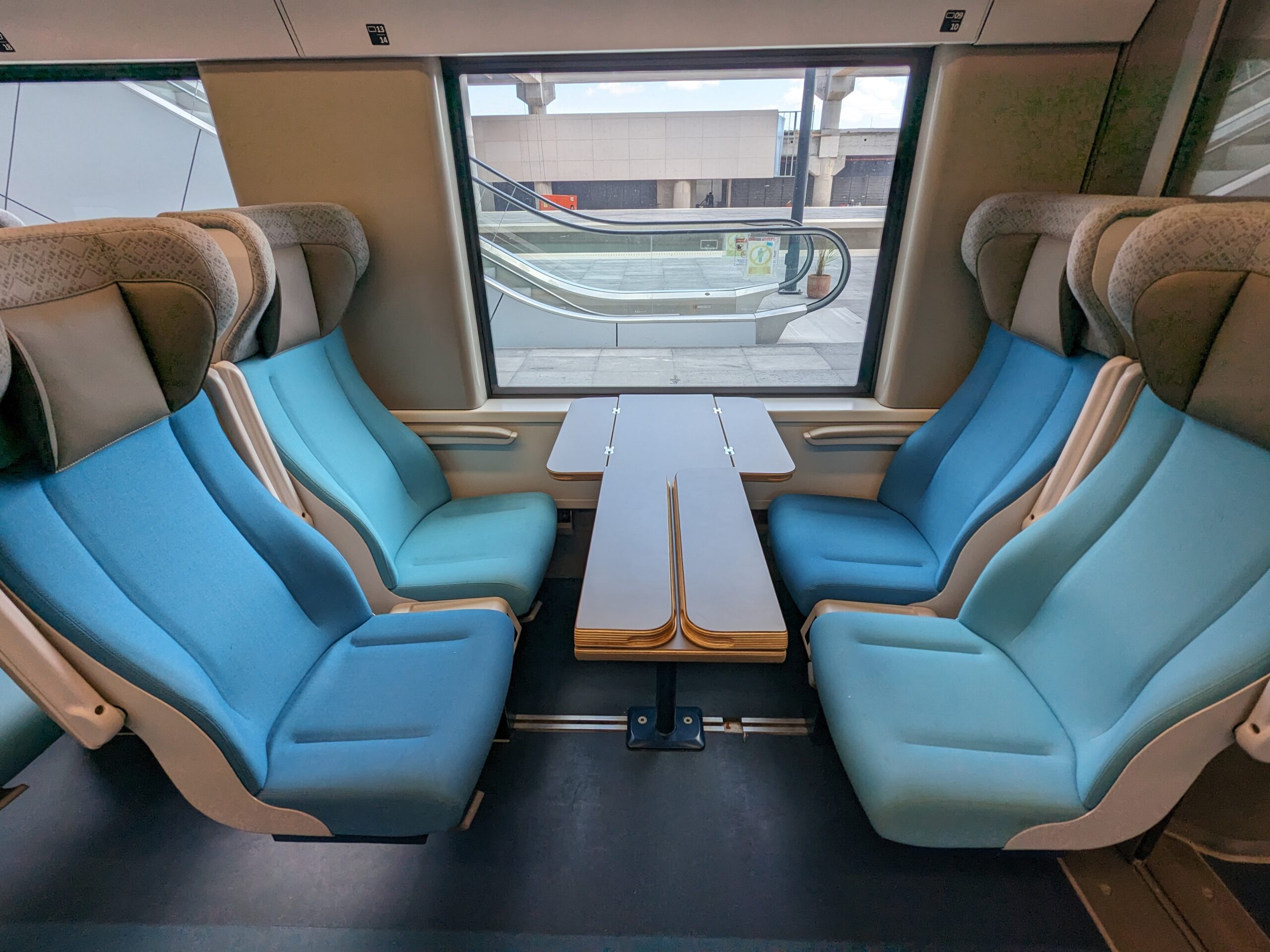
Seat numbers are assigned and listed on your ticket but since I didn’t purchase my ticket online, I’m unsure if it’s possible to choose your own seat or if they’re all automatically assigned. I wasn’t given a choice when buying my ticket at the station. Given how empty the train was, moving around to a different seat wasn’t an issue.
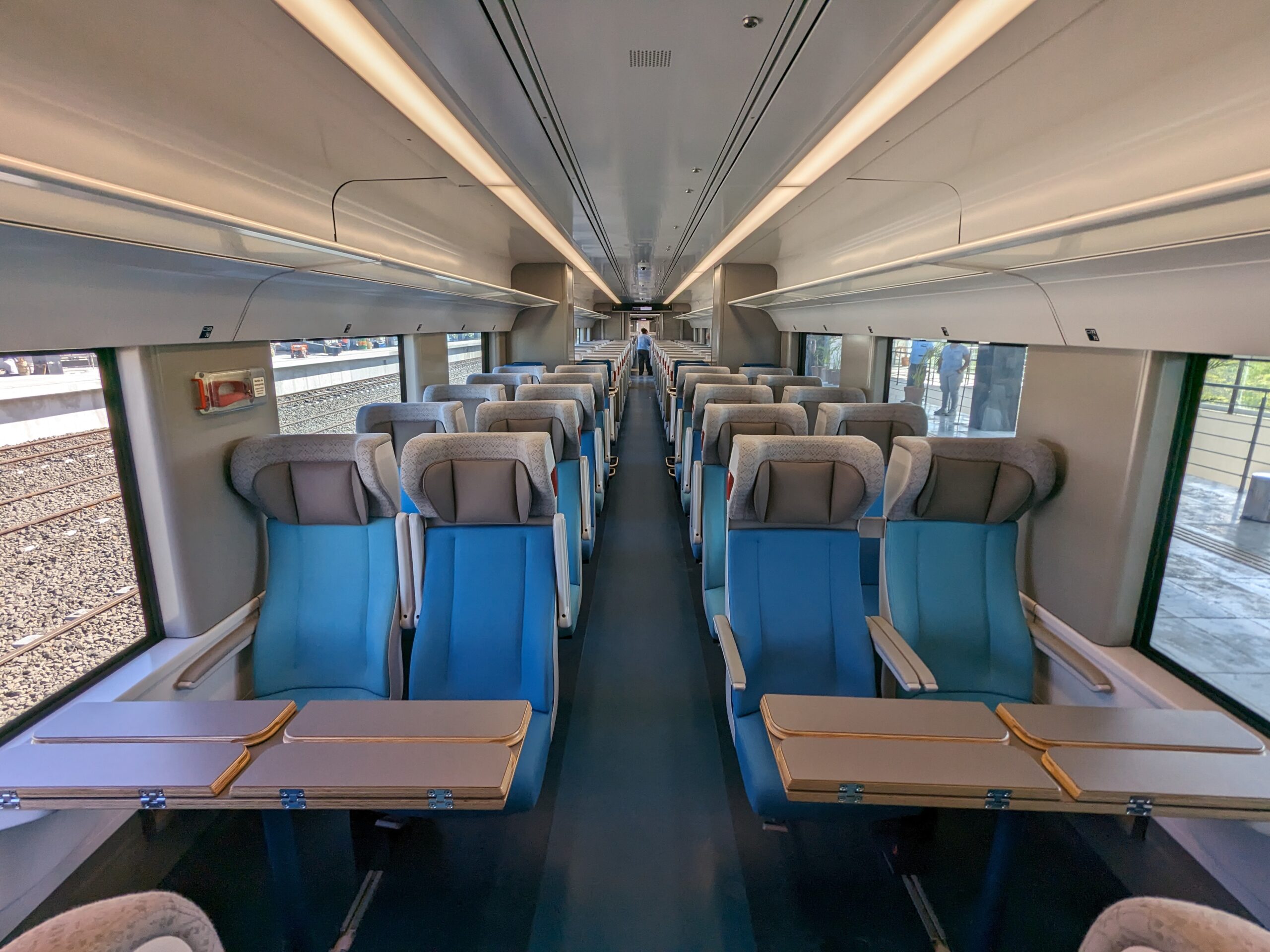
All seats included a footrest, power outlet, and USB charging, a mesh seat back pocket for storing small items, and a fold-down tray table.
Having a power outlet at every seat is a nice touch but it proved nearly impossible to use. After plugging in my phone charger it quickly fell to the ground. It fit so loosely that I had to hold it in place just to get it to work. I initially assumed this was just an issue with the outlet at my assigned seat but after trying others, I found they were all this way.
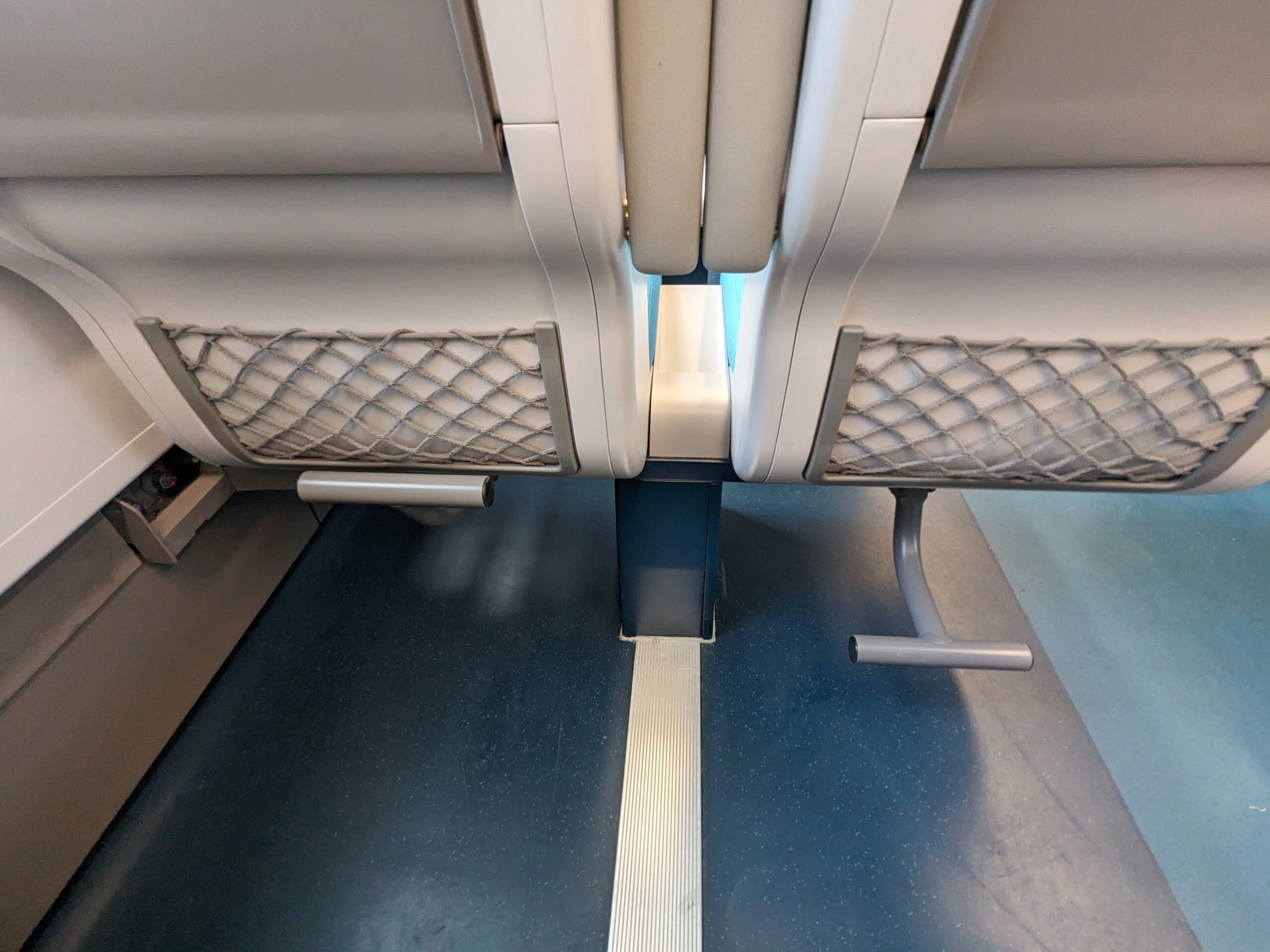
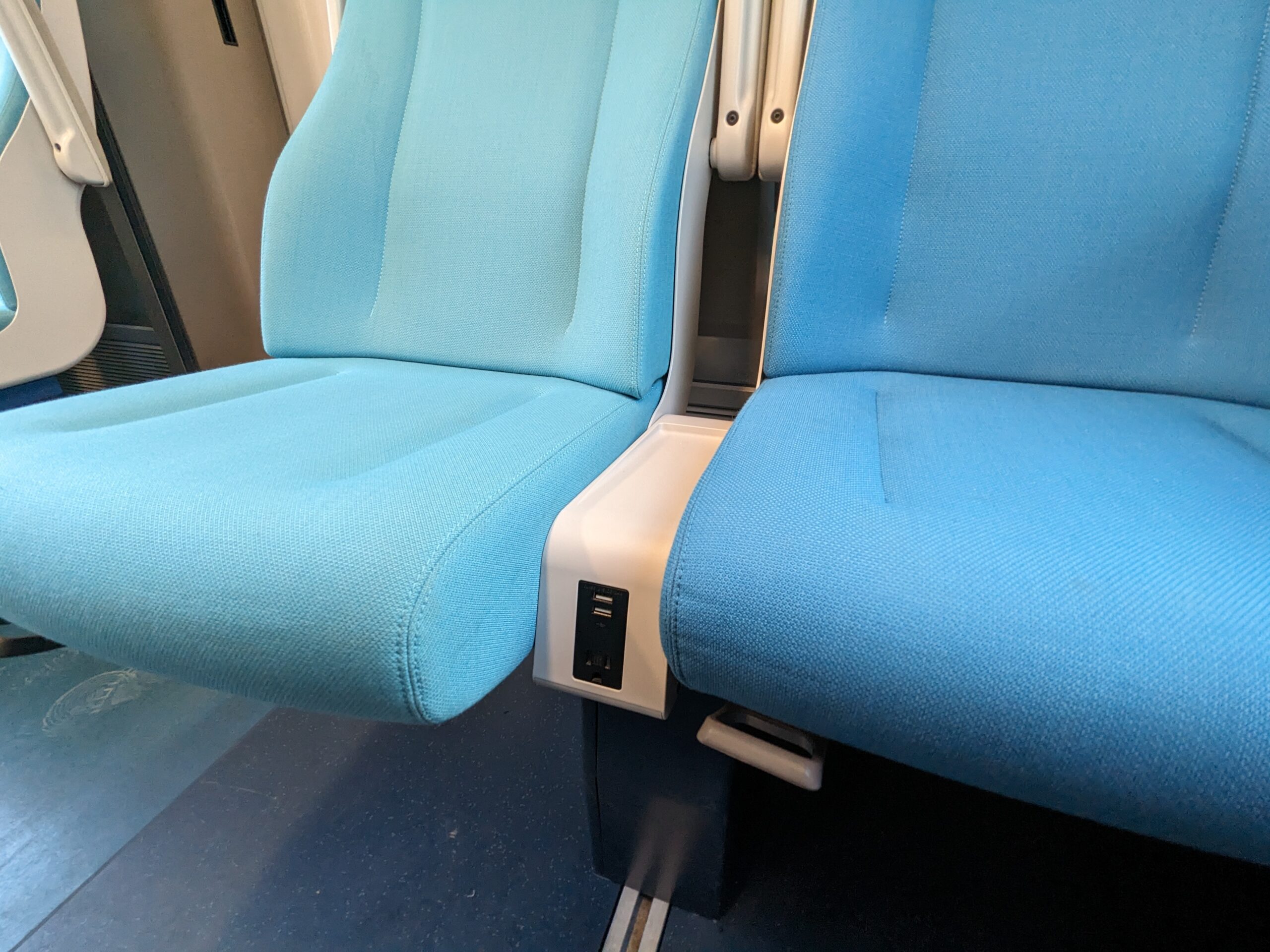
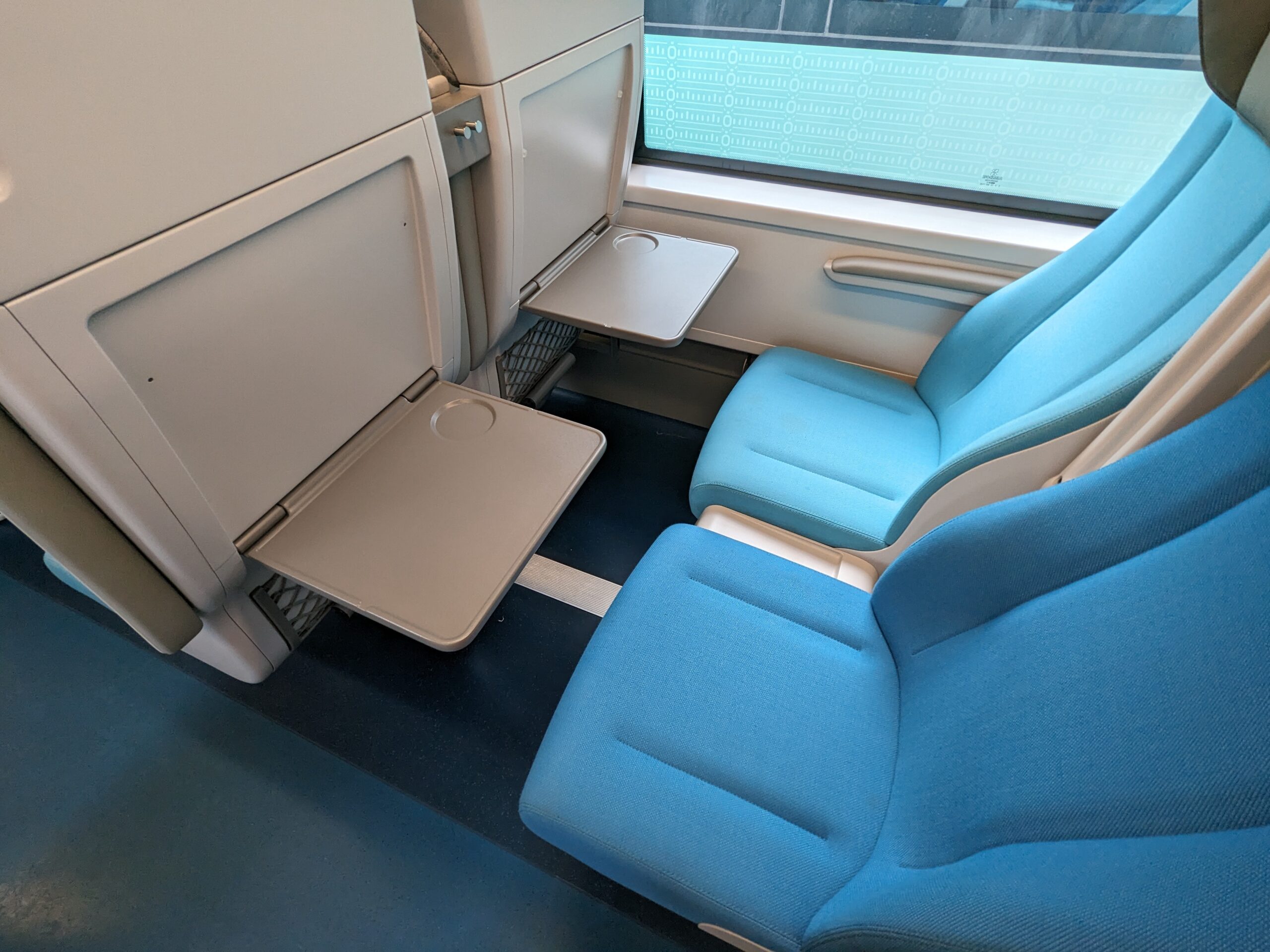
The seats didn’t recline but there was a lever that allowed the bottom seat cushion to slide forward in a way that made the seat feel as if it was reclined.
The trains are equipped with free Wi-Fi, but I wasn’t able to get it to work despite my best efforts. I instead relied on mobile data throughout the journey which went from excellent to non-existent to just OK, depending on where we were at. Long story short: Don’t plan to stay connected for the entirety of your trip at this point.
Onboard Experience
So what’s it like? I’ll be honest, I don’t have a lot of experience with rail travel – but after arriving at Playa del Carmen Station, I wasn’t ready to get off the train.
After making my way through the Premier class car, past the onboard dining, and back to my Tourist class seat, I was very impressed with the train as a whole. Everything was just so … nice. This is to be expected for a train that’s less than six months old but it’s a far cry from most Amtrak trains in the U.S. or even trains I’ve ridden in Europe.
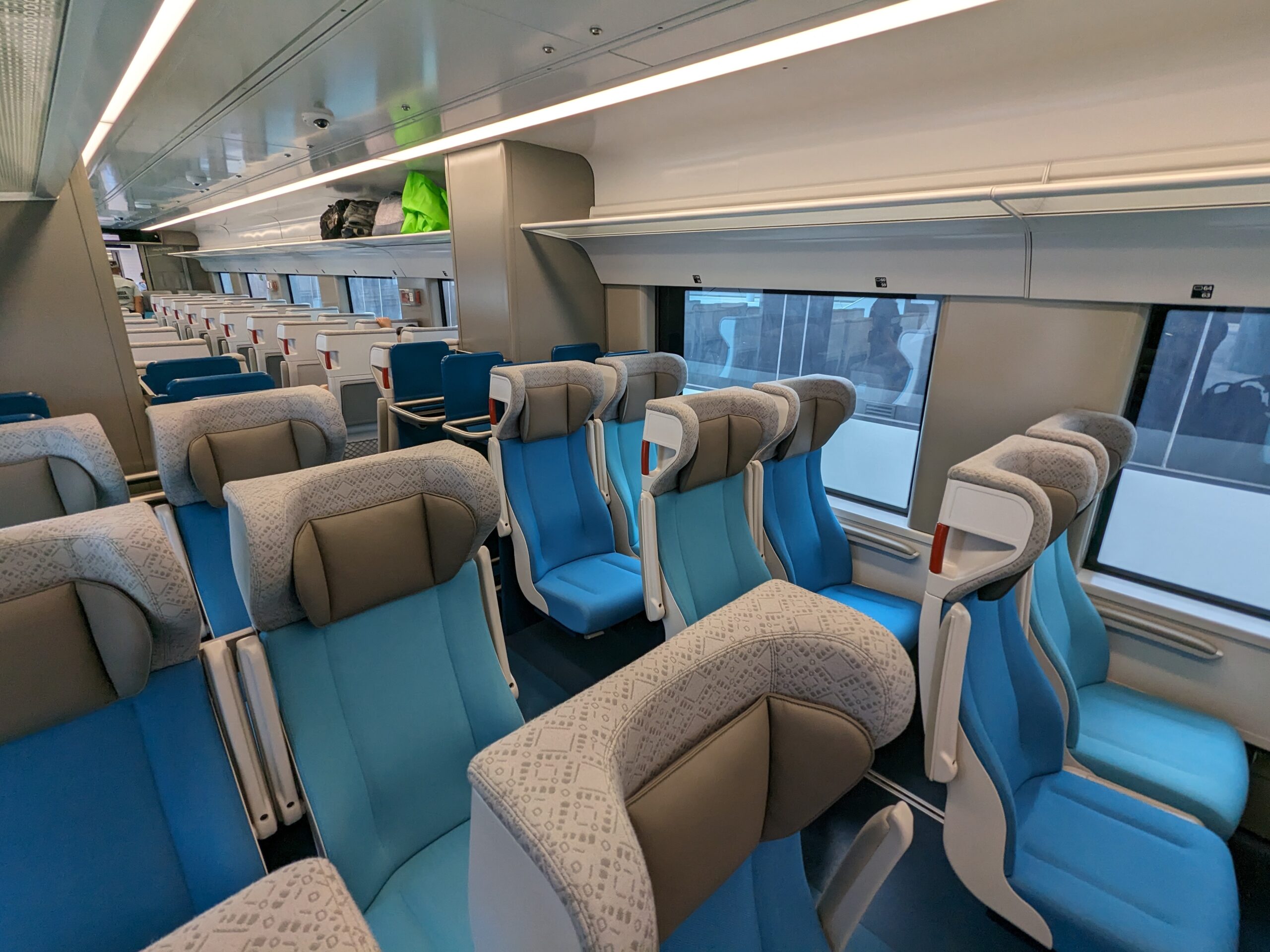
Our train departed right on time at exactly 3 p.m. and shortly after leaving the station, a Tren Maya representative made his way through the cars scanning everyone’s ticket one final time.
After getting a little way out of Cancún, it struck me just how quiet and smooth the ride was. I don’t know exactly how fast we were going – I’d guess we topped out around 60 miles per hour (far below the reported top speeds) – but it never felt like a rickety train ride.
Before I knew it we were pulling into Puerto Morelos station, our first (and only) stop between Cancún and Playa del Carmen. A family was getting on the train here but aside from a few Tren Maya officials standing around, the rest of the station looked quiet. This station appeared to be far more complete than the one in Cancún – probably due in large part to how much smaller it is.
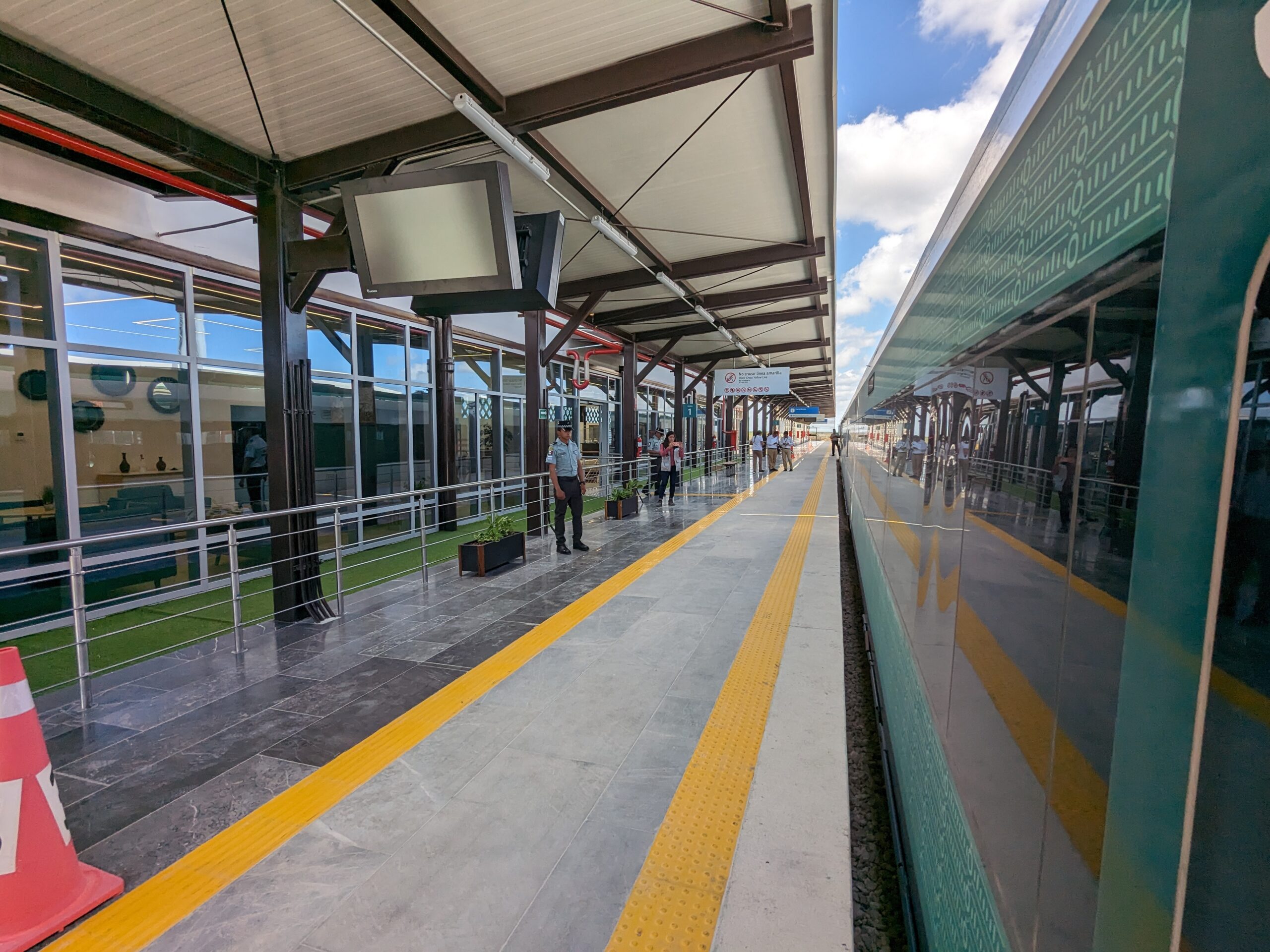
Along the way, we saw several construction crews working to complete projects along the track – many pausing their work to wave as the train rolled by.
At different points along the journey, it was evident just how much jungle had to be cleared to make the train a reality. The fact that the train runs over the top of subterranean caves and requires mass deforestation has made it a hot-button issue. Environmentalists have opposed the project from the start for the risk it poses to the region’s unique and fragile ecosystem.
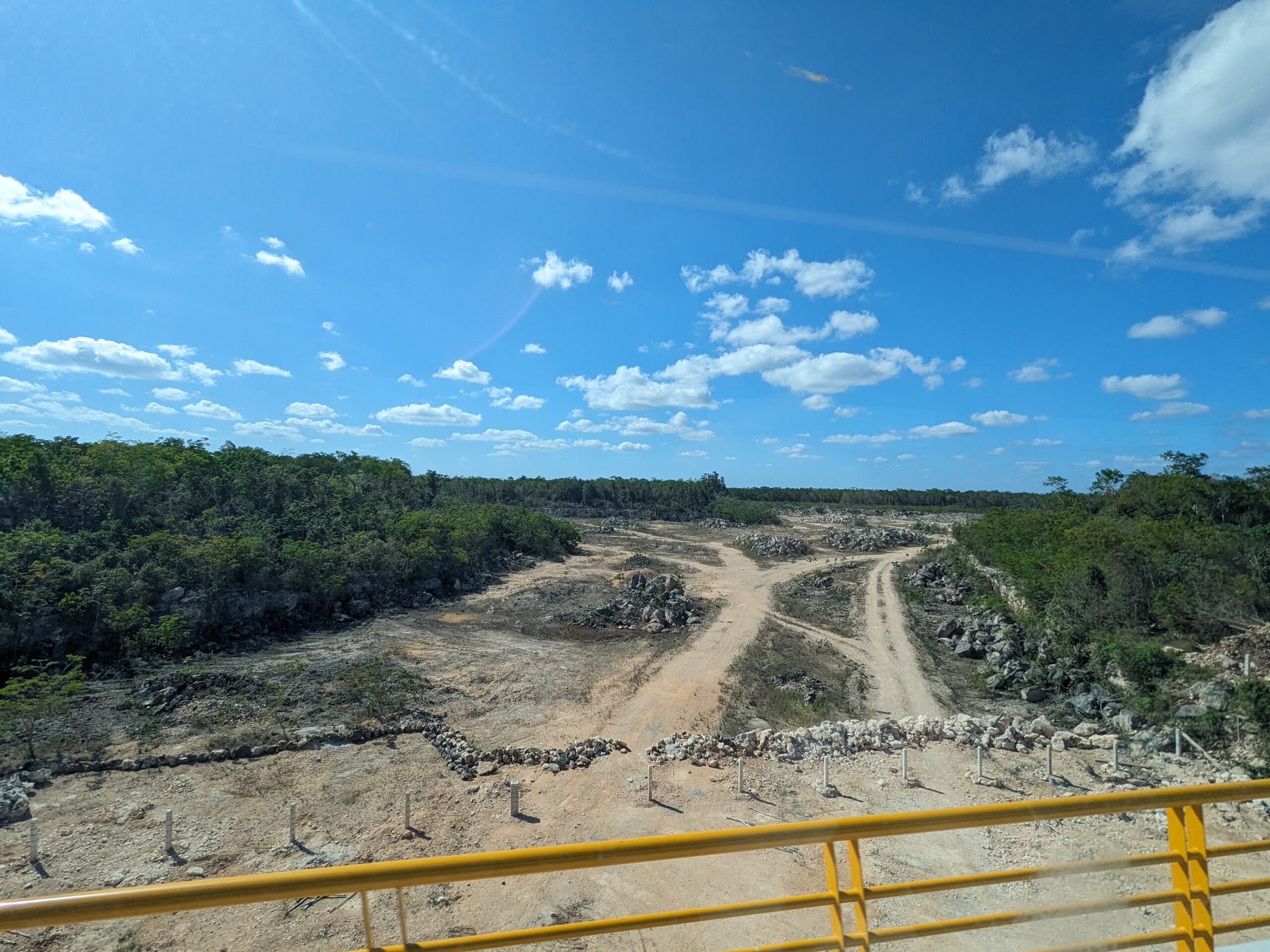
Before I knew it we were arriving at Playa del Carmen Station and the ride was over, exactly one hour after leaving Cancún.
Playa del Carmen Station
While this station was also not entirely finished, it was much closer to completion than the one in Cancún. After getting off the train at Playa del Carmen Station, I took the escalator down to the main level where a handful of passengers were waiting to board the train back north.
For passengers departing from this station, there is a permanent ticket window already up and running – unlike the temporary booth in Cancún.
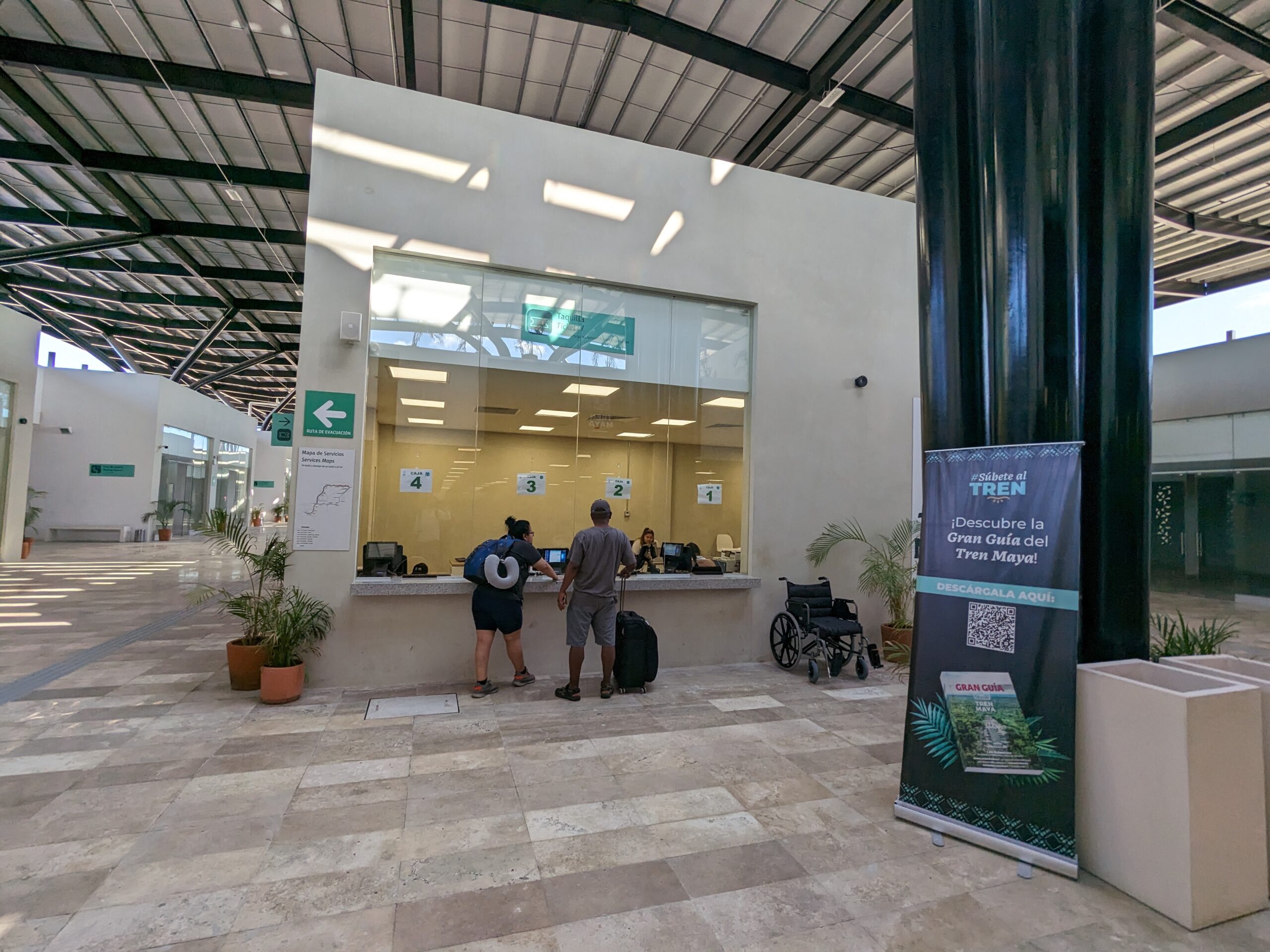
There is also space that’s currently designated as “waiting rooms” but could easily become a lounge option down the road for Premier class passengers or other frequent train travelers. There’s also plenty of space for future retail and food outlets to call home – but for now, it’s all empty.
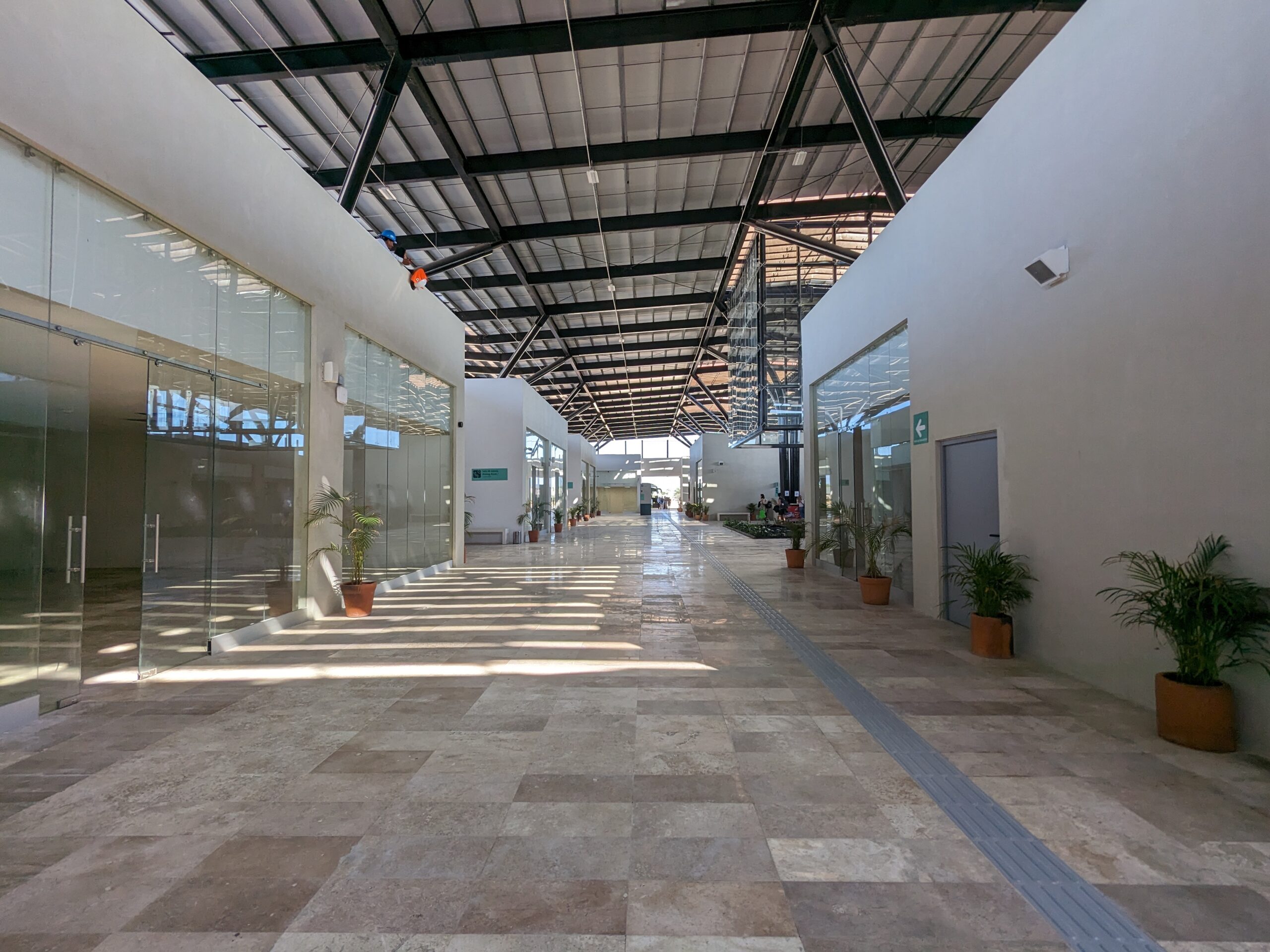
Near the entrance of the station, you’ll find a cool reflecting pool with a unique metal and glass structure suspended above it, reflecting the natural sunlight. In contrast to the potted plants meant to spruce up the other stations, and even featured throughout this one, the reflecting pool stands out as a nice design touch.
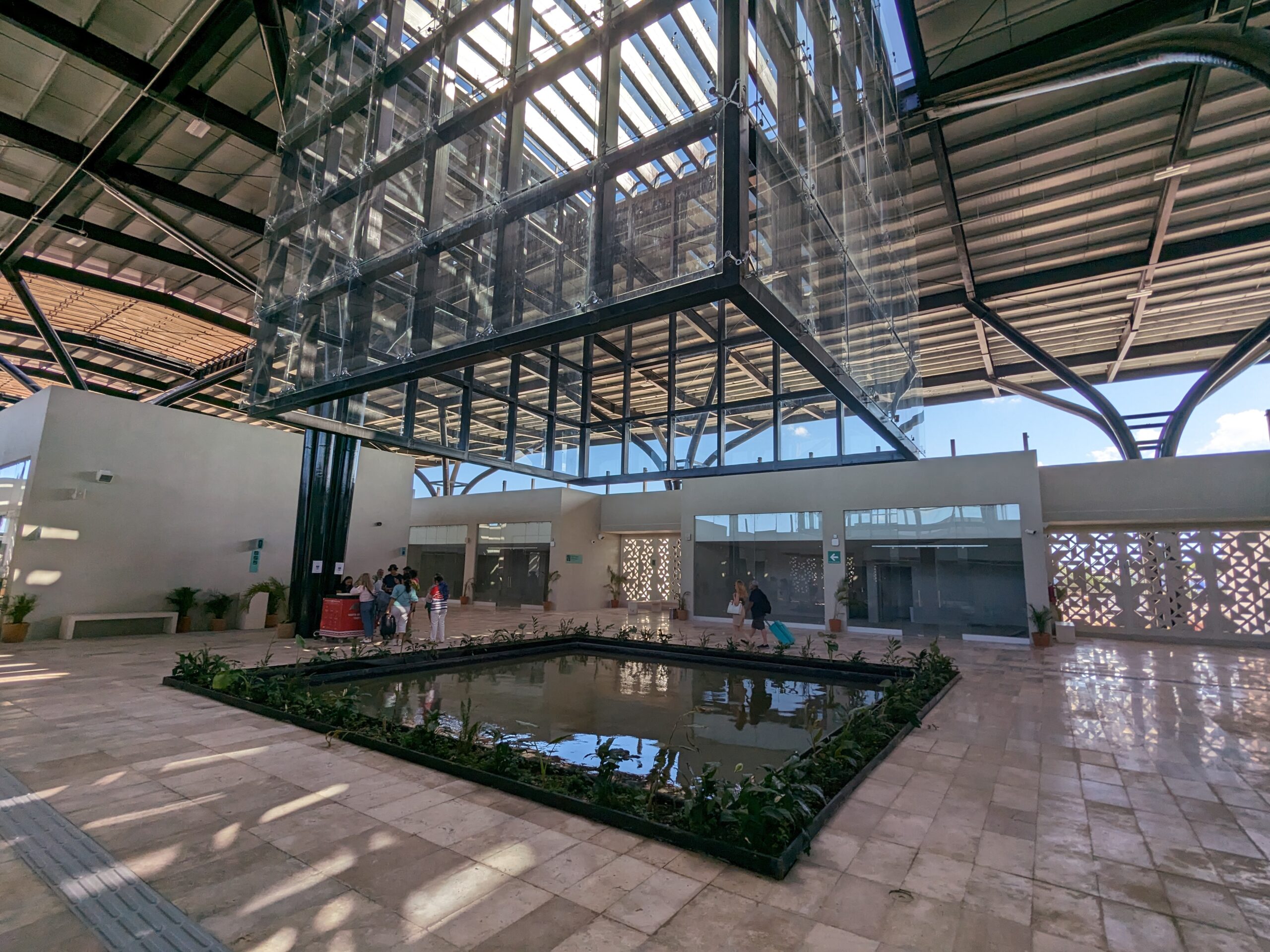
This is also where you’ll find the ticket booth for the shuttle bus that takes you into the Playa del Carmen city center and main hotel zone.
That’s right … after getting off the train, you’re still a 15 to 20-minute bus ride from the beach. There weren’t any taxis waiting at the station and rideshare services like Uber and Lyft don’t operate in this part of Mexico, so the shuttle is really your only option.
The shuttle service costs 55 pesos (about $4) and it’s cash only. Thankfully, I remembered to take out some cash at the Cancún airport as I didn’t see an ATM anywhere at the Playa del Carmen station and it was unclear whether or not they would have accepted U.S. dollars.
Is the Maya Train Safe?
Safety is always a concern when traveling, and it’s top of mind for many when visiting Mexico so it’s only logical to consider whether or not the new Mayan train is safe for tourists.
Tren Maya is operated – and partially built – by the Mexican army. As such, armed soldiers were posted at each station and on board the train itself. While this may seem alarming to some, as it could be seen as a heightened risk for danger, it’s the opposite.
Feeling safe is entirely subjective, but I never felt uneasy during my journey on the Maya Train. From what I could tell, I was maybe one of three or four international travelers riding the train that day and I’m far from a fluent Spanish speaker, which added another level of complexity to my trip. Between the military presence and the general professional of Tren Maya officials, I felt safe throughout the entire experience.
Is the Tren Maya Worth It?
Let me start by saying this was a really fun experience for me – and the train ride itself was surprisingly nice, especially compared to trains in the U.S. and some abroad. I love the logistics of traveling and there’s a certain level of excitement I get from just figuring this kind of stuff out on the fly. This was definitely an adventure that checked those boxes.
That being said, if you’re taking the Mayan train solely as a means of transportation, there are far more efficient – and maybe even cost-effective – options out there.
With shared and private shuttle services running up and down the Riviera Maya, you’re going to get to and from your resort far quicker – and easier – using one of those. It was nearly two hours from the time I boarded the train at Cancún Station until I got off the shuttle bus in central Playa del Carmen. Depending on where your hotel is, you might even need to take a taxi from there. In contrast, that journey would normally take 45 minutes to an hour by car.
In terms of cost, the train ticket itself was cheap enough – but once you add in the cost of the shuttle bus and a potential taxi ride, it starts to add up. If you’re traveling with a group, paying for a private shuttle will not only be quicker but it might also be cheaper once all things are considered.
But the train is brand new and only partially finished, so these kinds of growing pains are to be expected. I’m hopeful that in due time, they’ll figure out a more effective way to connect the stations to the main tourist areas and make it a much more viable option.
For those using the train to explore the region’s many archeological sites, while still staying near the beach, this could be the perfect solution to make seeing those otherwise hard-to-reach places a reality.
Bottom Line
Mexico’s new Maya Train officially opened in late December, connecting popular tourist destinations like Cancún, Playa del Carmen, and eventually, Tulum. This train provides travelers with a comfortable and fun experience but with hard-to-reach (and half-finished) train stations, it’s far from an effective means of transportation.
Here’s to hoping Tren Maya can work through its initial growing pains and become the preferred means of transit it’s intended for.
